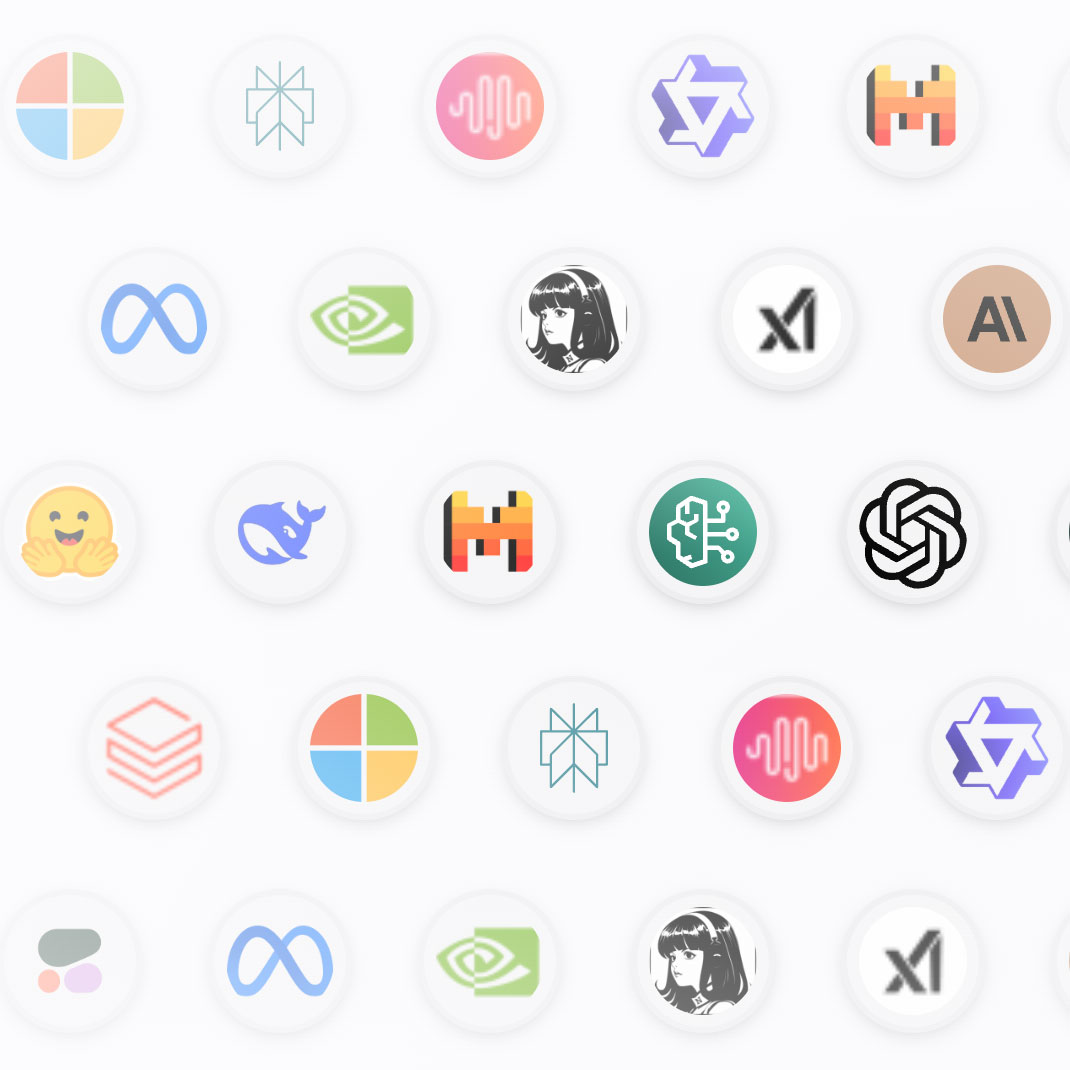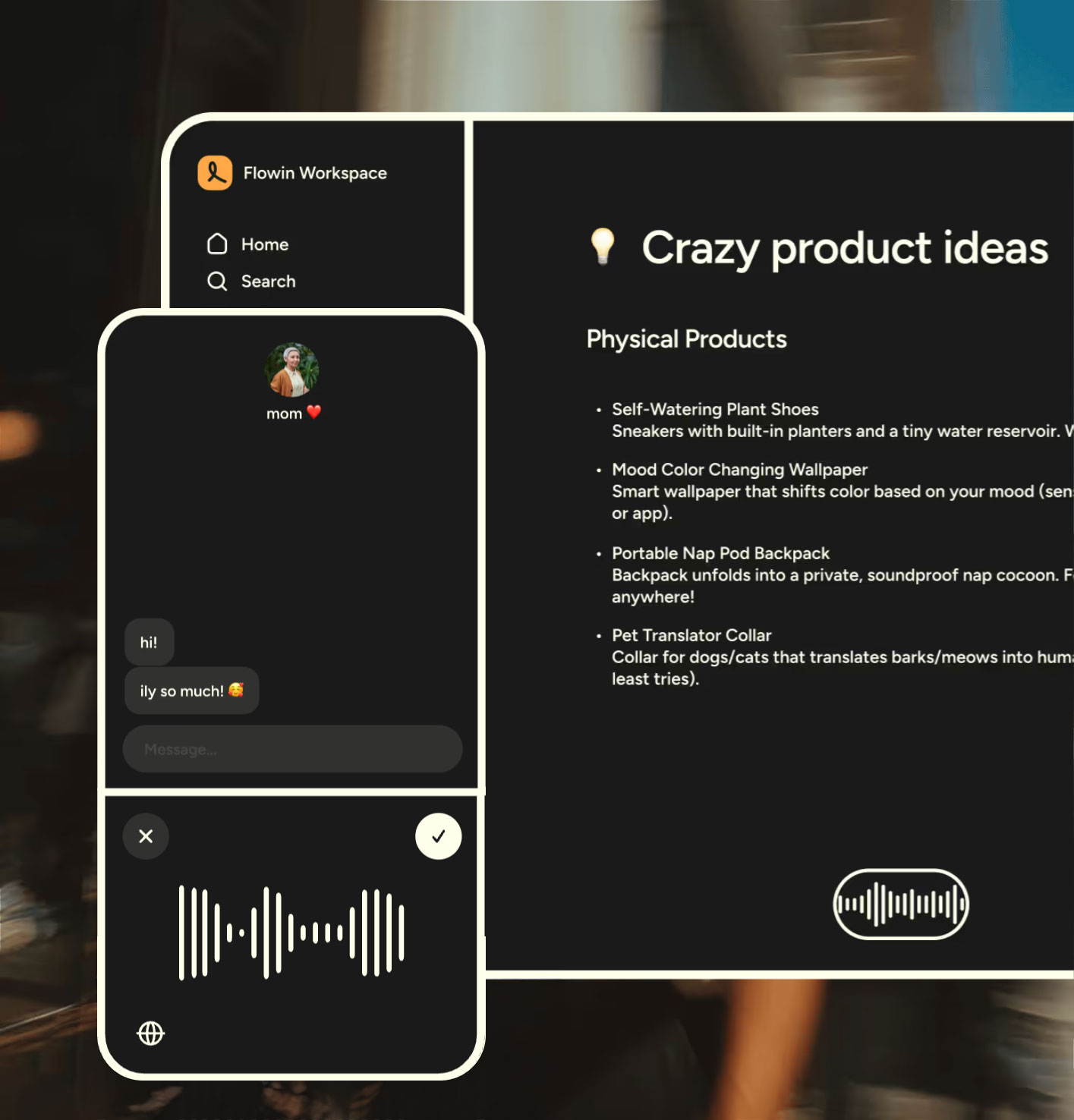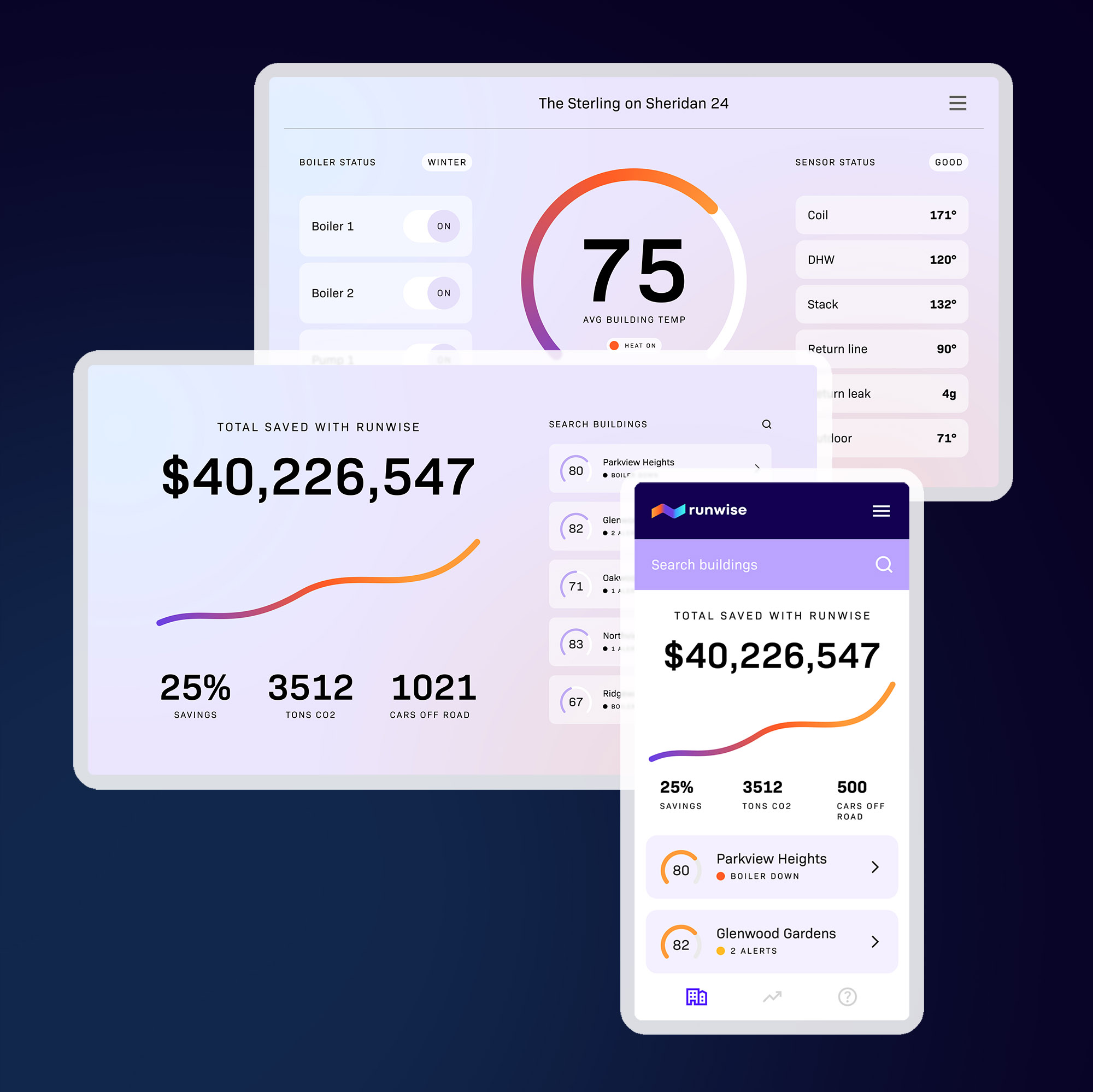AI’s Consumer Tipping Point Has Arrived
More than half of American adults (61%) have used AI in the past six months, and nearly one in five rely on it every day. Scaled globally, that translates to 1.7–1.8 billion people who have used AI tools, with 500–600 million engaging daily.1 This is no longer experimentation; it’s habit formation at an unprecedented scale.
Beneath the hype, real usage patterns are more nuanced than expected. They expose hidden gaps and huge opportunities for founders building the next generation of consumer AI products. In this report, based on a survey of over 5,000 U.S. adults,2 we unpack what’s fueling this adoption, where value is leaking, and how the smartest companies can capture it—revealing the driving forces behind the consumer AI revolution.
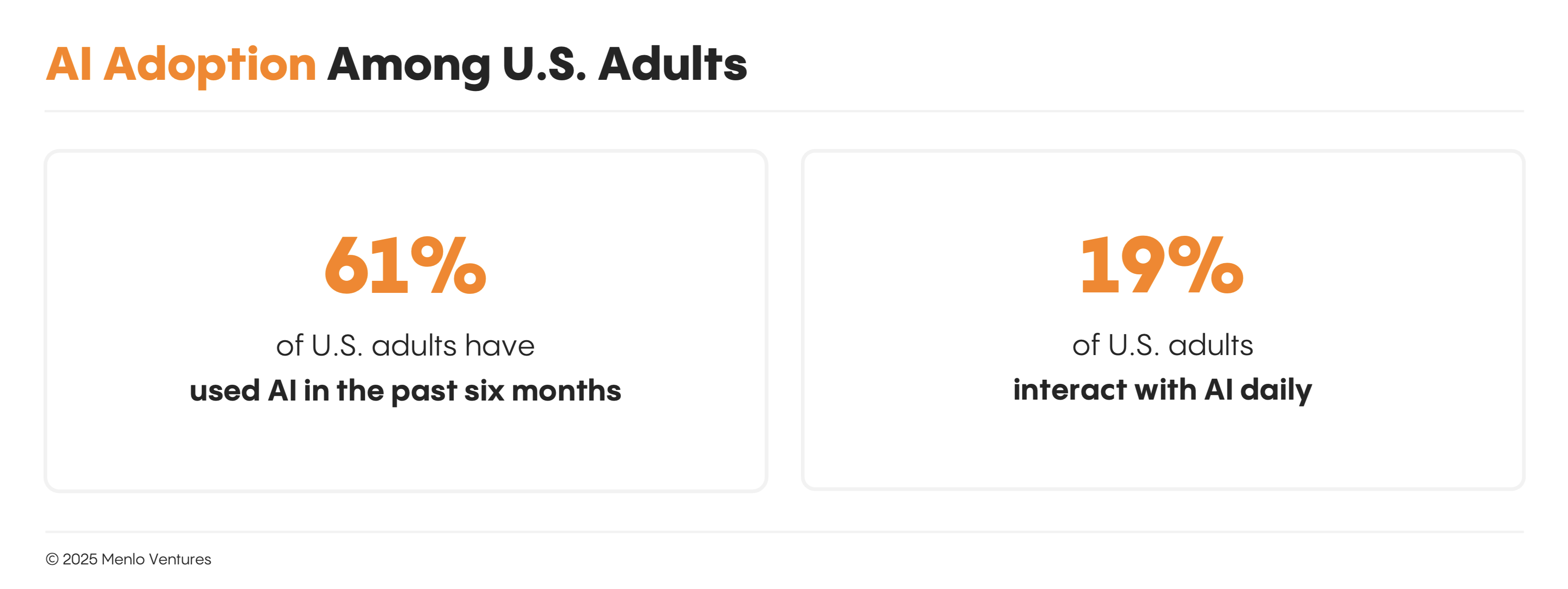
A $12 Billion Market Built in 2.5 Years
This rapid adoption drives real dollars: In the two and a half years since OpenAI’s ChatGPT introduced the public to generative AI, consumer AI has become a multibillion-dollar market.
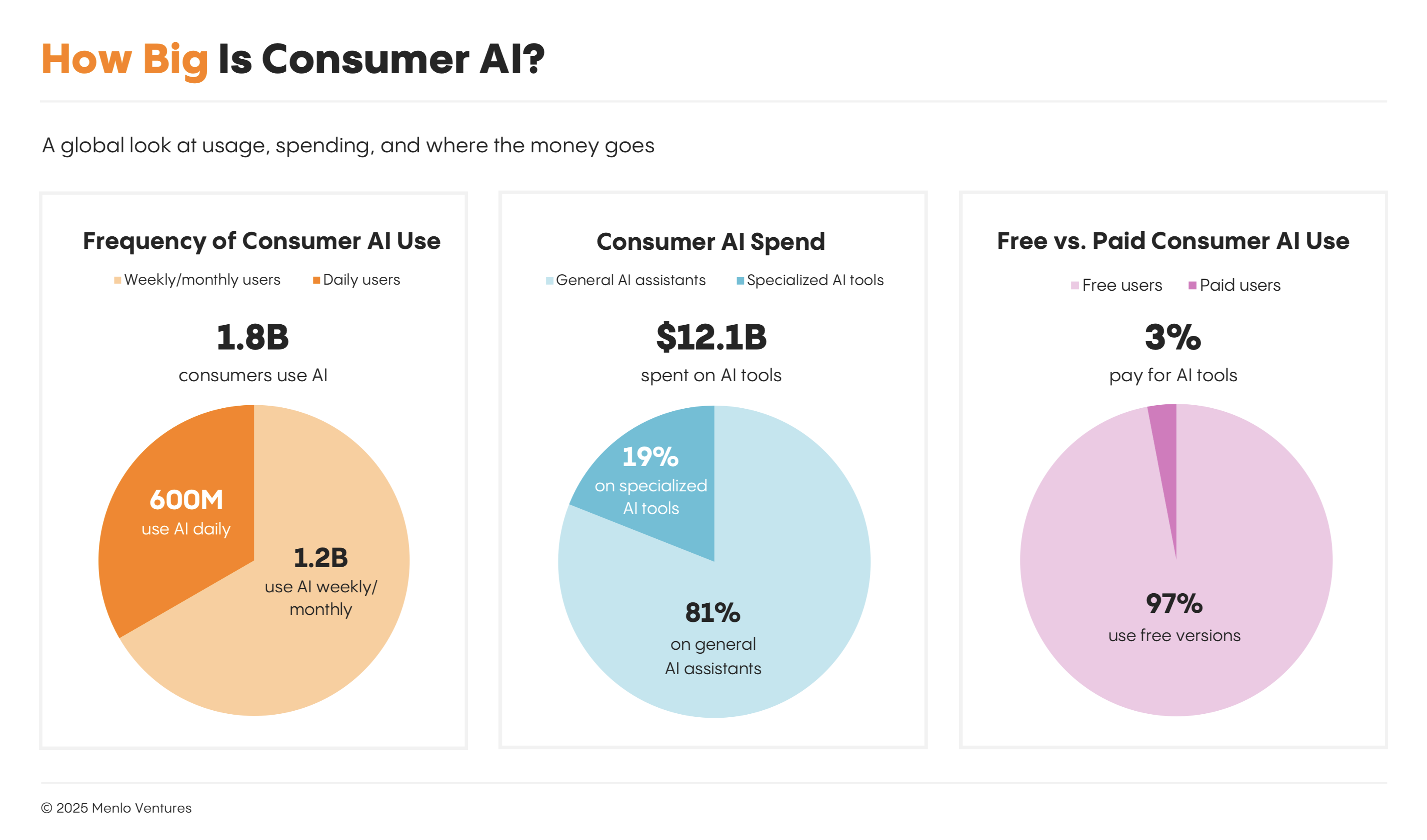
When we do the math, 1.8 billion users at an average monthly subscription cost of $20 per month equals $432 billion a year; today’s $12 billion market indicates that only about 3% pay for premium services—a strikingly low conversion rate and one of the largest and fastest-emerging monetization gaps in recent consumer tech history.3 Even ChatGPT, with its first-mover advantage, only converts about 5% of its weekly active users into paying subscribers.4 This gap between usage and payment represents a major opportunity.
For context, Menlo Ventures’ 2024: State of Generative AI in the Enterprise report found that enterprise AI spend reached $13.8 billion in 2024—a more than 6x increase from the prior year. But we believe consumer AI will close the gap with broader reach and faster adoption, catching up to enterprise AI in both usage and total revenue generated.
With nearly two-thirds of Americans reporting they’ve used AI, we wanted to know, who are the drivers of adoption? The answer challenges conventional wisdom about digital natives and early adopters.
Who’s Using AI? The Stats May Surprise You
AI Adoption Spans All Generations, With Some Unexpected Patterns
While Gen Z (ages 18-28) leads overall AI adoption as expected, Millennials (ages 29-44) emerge as power users, reporting more daily usage—flipping the typical “younger = higher usage” pattern. But AI is not just a young person’s game: Nearly half (45%) of Baby Boomers (ages 61-79) have used AI in the past six months, with 11% using it daily.
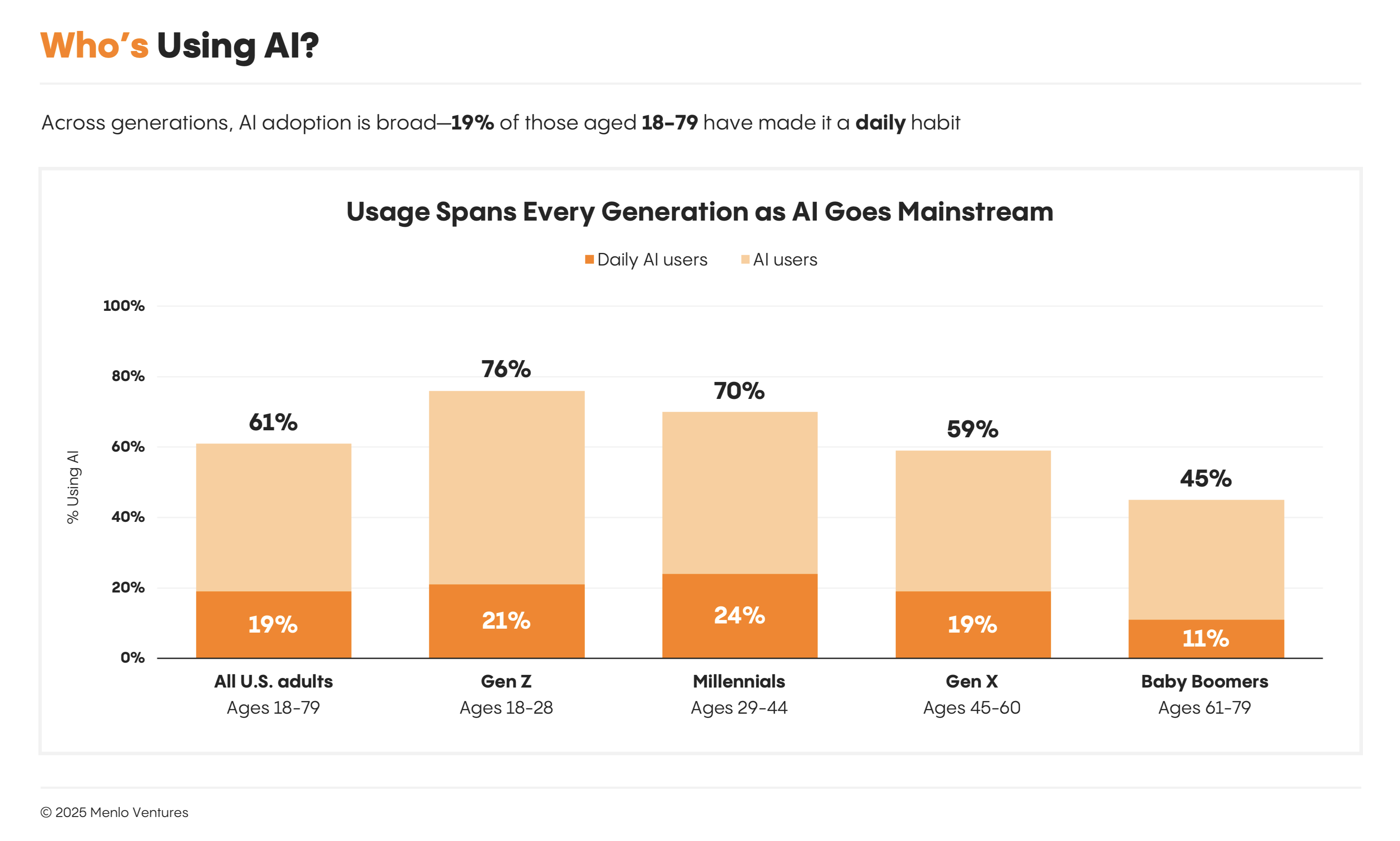
Work and School Fuel Everyday Adoption
It’s hardly surprising AI adoption spikes among students and those who work. According to our survey:
- 75% of employed adults use AI, compared to 52% of unemployed adults;
- Higher income amplifies this: 74% of households earning $100,000+ annually use AI vs. 53% of households earning under $50,000, highlighting a familiar income-based digital divide;
- 85% of students (18 and older) report using AI—the highest rate of any group we measured.
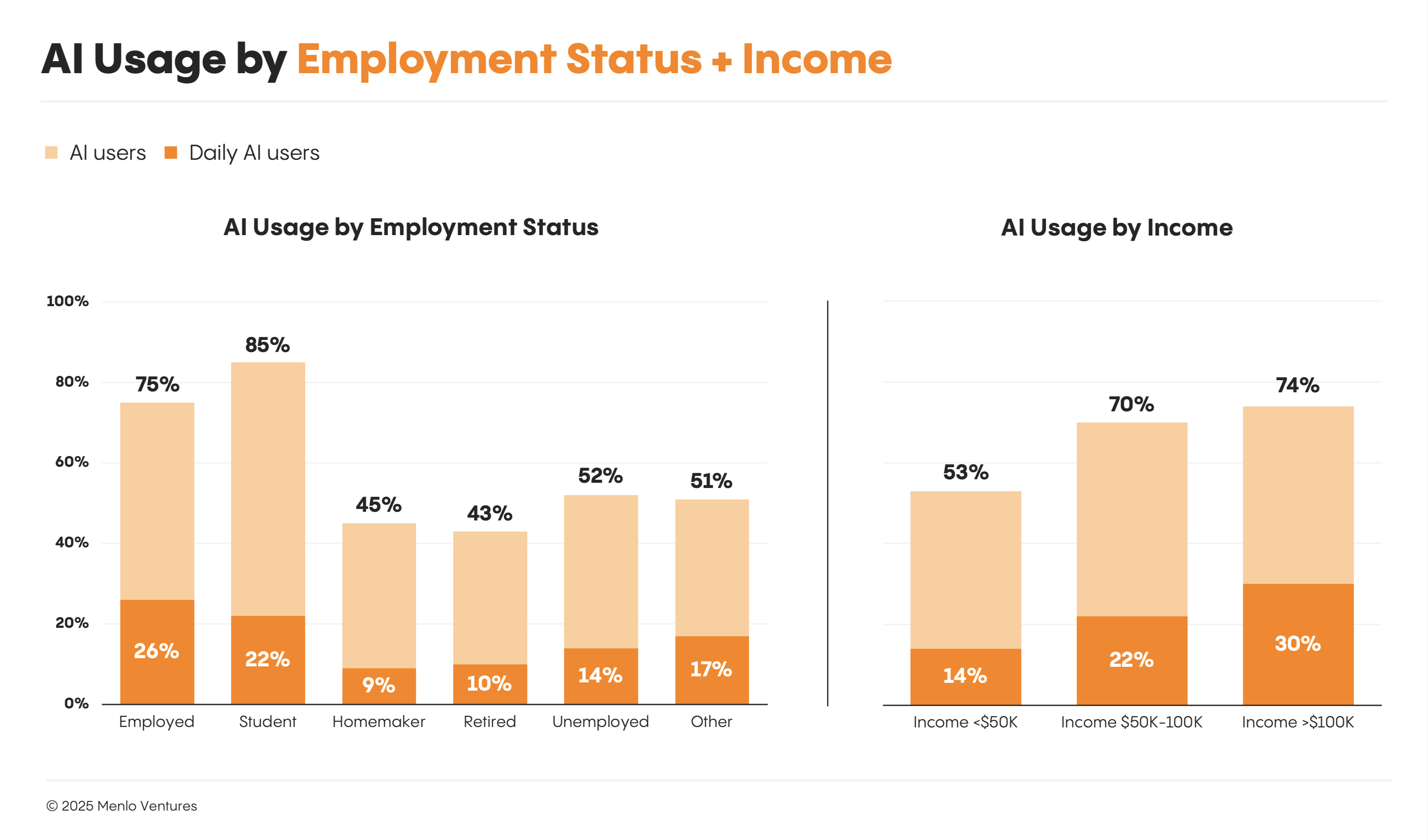
Parents: The Unexpected Power Users
One of the most surprising findings? Parents are among the most engaged AI users, turning to AI for everyday help.
Among parents with children under the age of 18:
- The vast majority of parents (79%) have used AI compared to 54% of non-parents;
- 29% report using AI every day, nearly twice the rate (1.9x) of non-parents (15%);
- Top use cases: 34% for managing childcare, 28% for researching topics of interest, 26% taking and organizing notes;
- Millennial parents rank highest: They make up 53% of parents with kids under 18 and are more likely to be working, earning higher incomes.
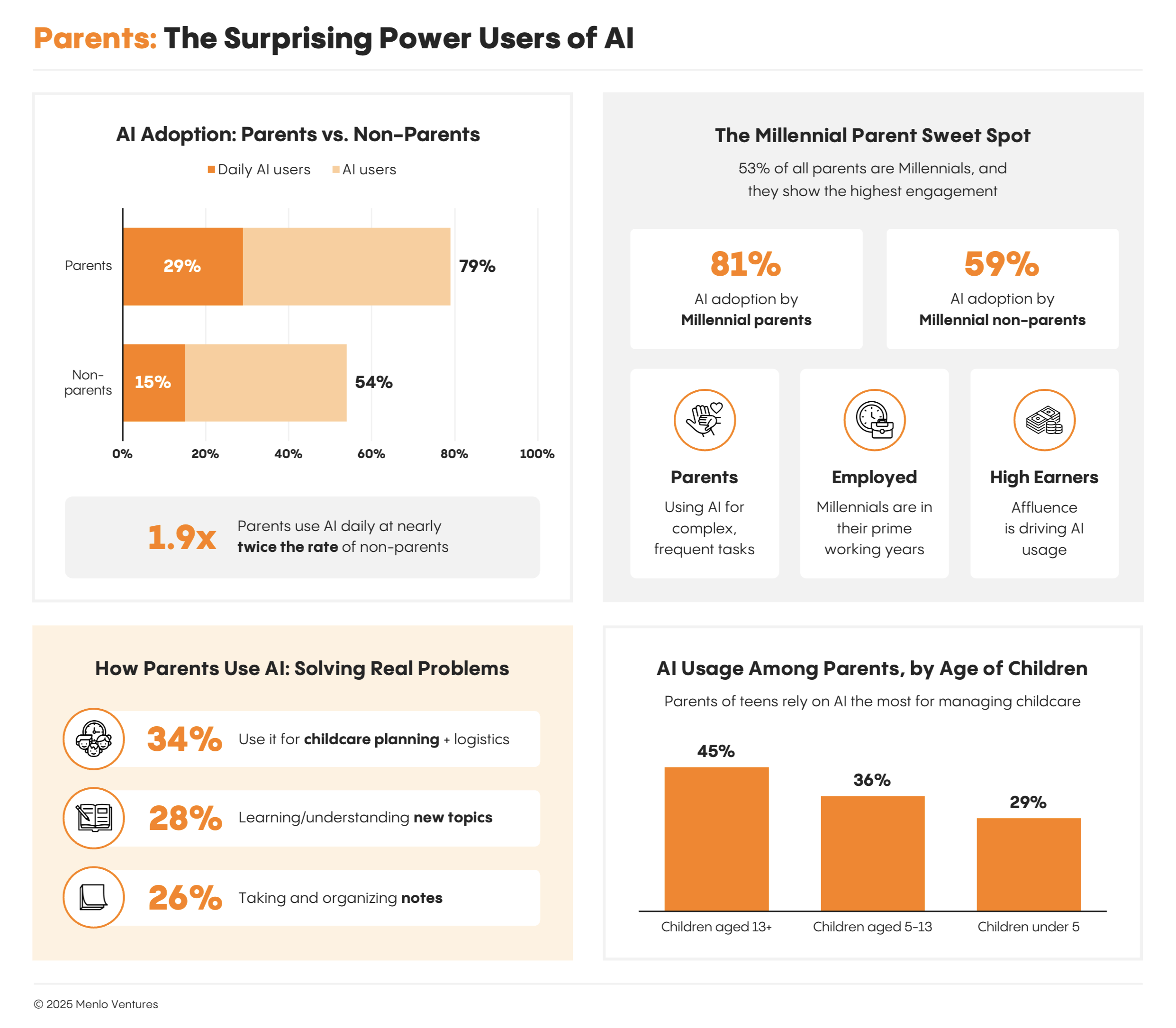
I use AI all the time. We use it to make packing lists for my kids when we travel.”
—44-year-old working mom with children in primary school
I used it for planning a scavenger hunt on Easter.”
—34-year-old stay-at-home mother of two
The Complexity Curve: AI Use Increases as Children Grow
Interestingly, AI usage among parents increases as their children get older, reflecting added family complexity and responsibilities:
- Nearly half (45%) of parents with children over 13 use AI;
- More than a third (36%) with children aged 5-13 use AI;
- Nearly a third (29%) of parents with children under 5 use AI.
When I’m feeling uninspired, I use AI for meal planning and ideas for packed lunch.”
—38-year-old working mom of teen
I use AI to help my daughter when she struggles with math concepts. It gives me tricks to help her remember rules and formulas, and sometimes we use it to create practice tests with answer keys based on the worksheets she brings home so that she can prepare for tests.”
—51-year-old working mom of teen
Takeaway: The adoption patterns we see among parents show that consumer AI adoption follows life-stage complexity more than just age or income. This points to an adoption curve shaped by high-friction “life moments” that savvy companies can target as wedges to build lasting habits.
The Utilitarian Truth Behind the Numbers
Routine Tasks → Small Wins → Compounding Value. This pattern is consistent across our power users who turn to AI because it makes life easier. This validates Menlo Ventures’ “utilitarian consumer” thesis: People adopt tools that help them do what they already need to do, but in a better, faster, cheaper way.
The broad appeal of AI is striking: millions of people, across all demographics, applying it to nearly every aspect of daily life. Beneath this diversity is a remarkably consistent behavior pattern, making AI the most broadly utilitarian new technology we’ve seen in years.
The Default Tool Dynamic: Consumers Choose Convenience Over Specialization
When we asked people which AI tools they use, one trend was unmistakable: Most stick with familiar general AI assistants for almost every task, despite countless specialized apps to choose from. Consumers typically test their preferred general AI tool first—no matter the task—and only look for alternatives when it comes up short. Driven by this “default behavior,” generalist platforms dominate: 91% of AI users reach for their favorite general AI tool for nearly every job. About a quarter of Americans report using ChatGPT (28%) or Google Gemini (23%) in the past six months, indicating that consumer adoption today is largely driven by embedded products with existing distribution.5
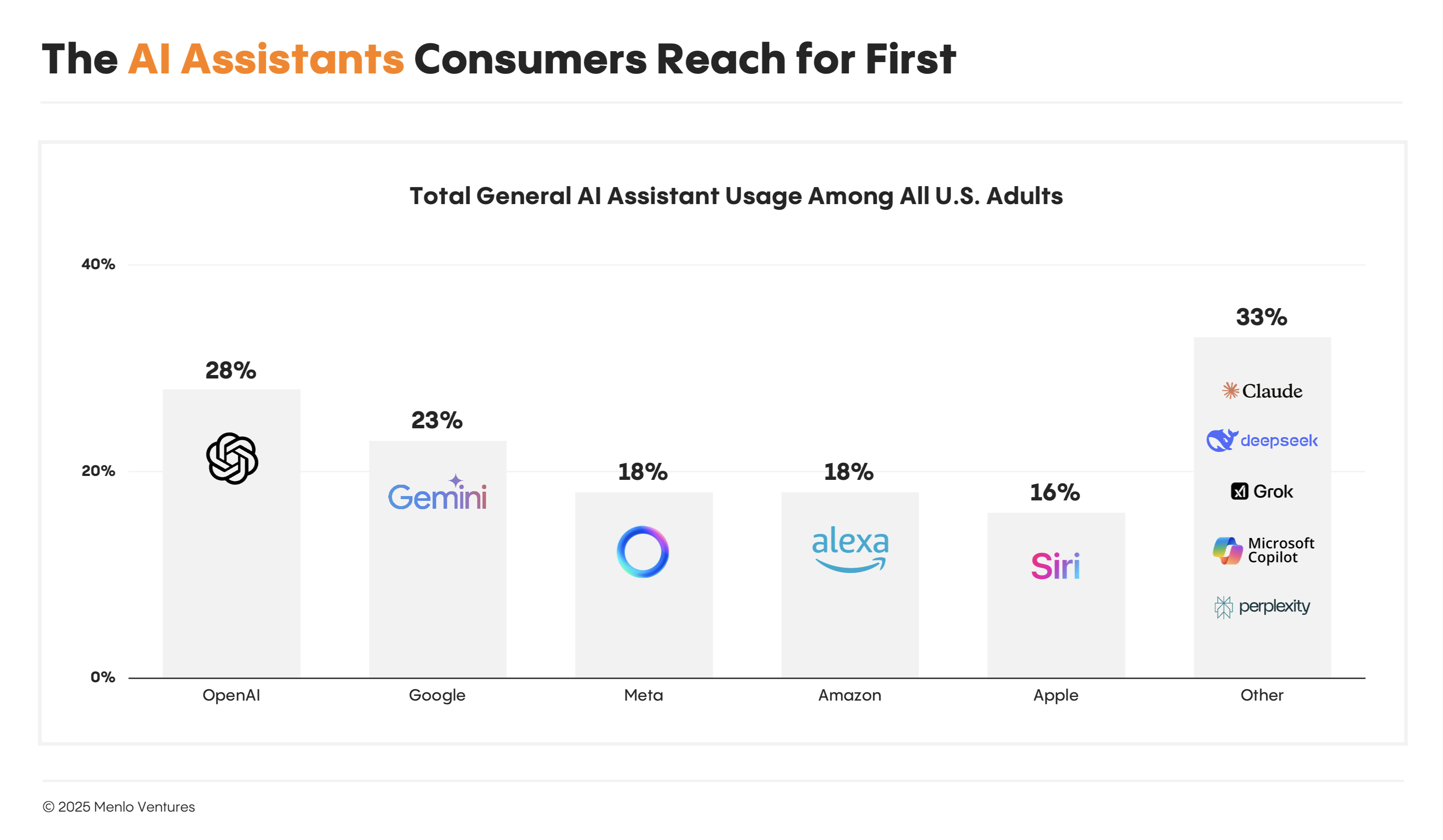
While ChatGPT leads today in consumer usage, that position is not guaranteed. The consumer market for LLMs is still nascent and far from saturated, leaving ample room for product innovation to shift market share over time. Challengers are moving fast: Anthropic’s* Claude Opus 4 outperforms OpenAI’s GPT‑4.1 on many reasoning and factuality benchmarks, making it a preferred choice for enterprises, while Google’s Gemini 1.5 models boast massive context lengths of up to one million tokens, an area where ChatGPT’s consumer version still lags. Other players like Perplexity have gained traction by chipping into the AI search niche once synonymous with ChatGPT. And in specific consumer use cases like coding, Claude Code is becoming the runaway market leader compared to other LLM providers.
For consumers, switching costs are practically zero; there’s no data migration, no sunken cost. Meanwhile, Big Tech incumbents are embedding LLMs directly into the everyday tools people already use: Google is weaving Gemini into Search and Gmail; and Amazon’s ecosystem, which includes the voice-driven virtual assistant Alexa, is receiving an intelligence upgrade through their partnership with Anthropic*. AI is being baked into keyboards, browsers, and operating systems. If your assistant is everywhere you type, why open a separate app?
However, consumers aren’t reliant solely on general AI tools. Sixty percent of users report using both general AI assistants and specialized AI tools—a signal that more advanced workflows are emerging. Specialized tools only gain traction when they clearly outperform the default option.
I use ChatGPT for everything. But I go to Gamma for slides.”
—30-year-old designer
I use Claude for 90% of things I need from AI.”
—38-year-old engineer
It’s worth noting that our survey revealed that most people don’t distinguish between older assistants like Alexa and Apple’s Siri*, algorithmic recommendations like Netflix or TikTok, and newer large language models like ChatGPT and Claude*. Technically, these rely on very different technologies, but to consumers, they all feel like “AI.” For both Siri and Alexa, distribution and habit sustain usage regardless of technical sophistication.
Takeaway: The reach of general AI assistants means consumers will almost always try their default tool first. Yet the consumer market for LLMs is still in its early days: far from saturated and very much up for grabs as new capabilities, better models, and deeper integrations reshape how and where people use AI in daily life. As gaps persist and the market matures, consumers will increasingly pick the best LLM based on fit for the task and personal needs.
Market Concentration: $10 Billion Flows to General AI Leaders
This default-first behavior drives massive revenue concentration: General AI assistants capture 81% of today’s $12 billion consumer AI spend. OpenAI’s first-mover advantage made ChatGPT the dominant player in this early market, accounting for about 70% of total consumer spend and 86% of spending on general AI tools specifically.
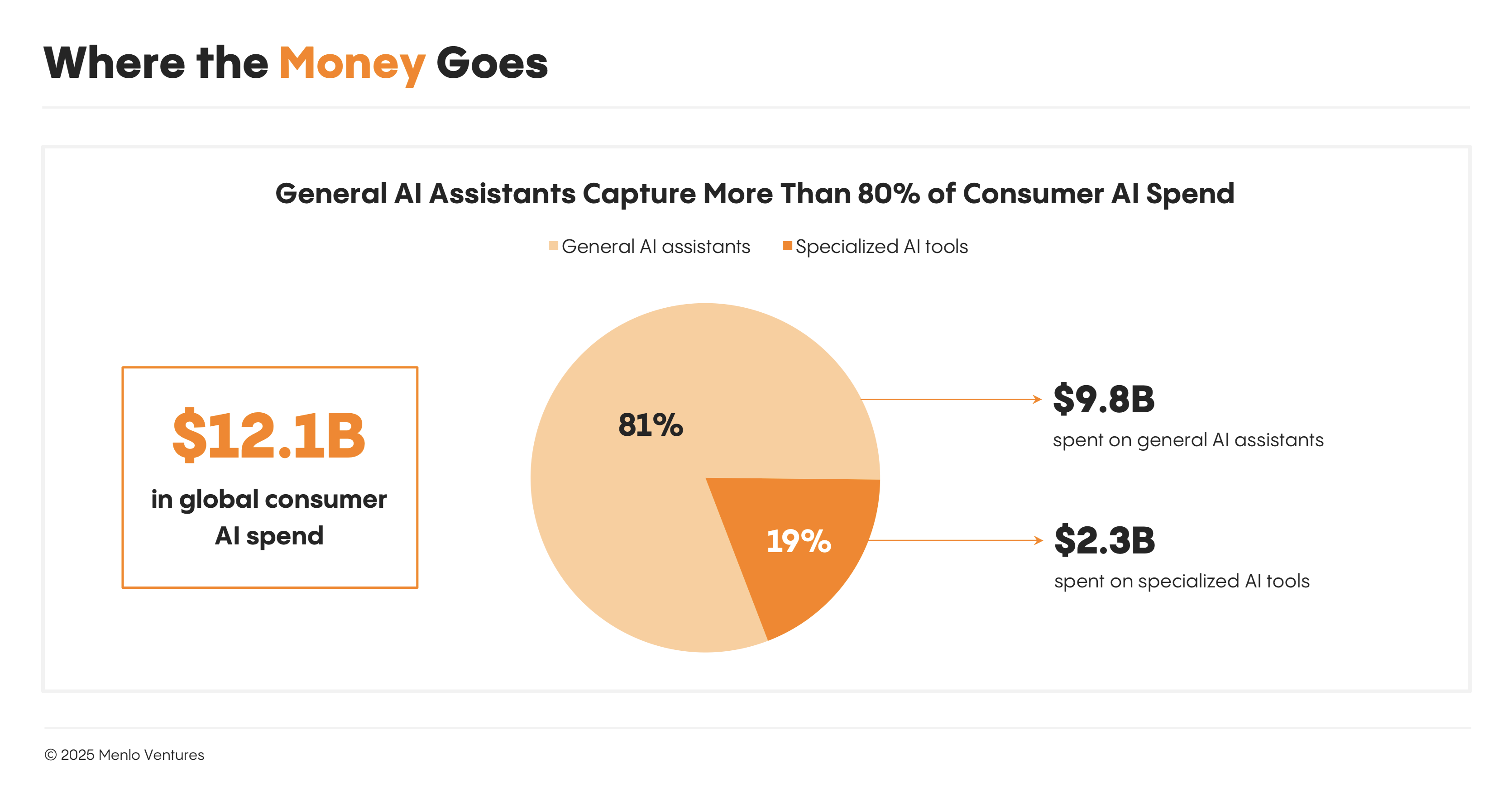
A harsh reality for challengers: Many specialized tools run on the same foundation models as the general AI assistants they compete with. This co-opetition creates real tension: Each new LLM release absorbs more intelligence and specialized features, making entire categories obsolete overnight. Competing head-on is like building in front of a moving bulldozer: Unless these tools move fast, build deep domain stickiness, and deliver something the default can’t replicate, they risk being crushed.
Takeaway: For consumers, convenience beats capability—until it doesn’t. Most users stick with their default tool unless a new one is dramatically better, following the classic 10x rule. For specialized tools to win, they must break users’ habits with experiences so superior, efficient, or personalized that switching becomes inevitable. It’s a high bar. So where’s the opportunity? In the friction: the tasks where general AI assistants fall short, frustrate users, and leave room for specialists to shine.
A lot of times it just comes down to the fact that [using AI] is a habit and routine. I have used it for a while now. It is also convenient with the technology and brands that I own.”
—46-year-old man
Daily Activities: Where AI Is Gaining Traction in Everyday Life
We wanted to cut through the hype to understand how everyday people are actually using AI in their personal lives. We surveyed respondents across five core categories of activity that capture how we spend our time: Routine Tasks, Physical and Mental Health, Learning and Development, Connection, and Creative Expression.
For each category, we highlight how people are using AI, what tools they choose, and the key insights behind adoption patterns to show where momentum is building, which behaviors are changing, and where opportunities remain untapped.
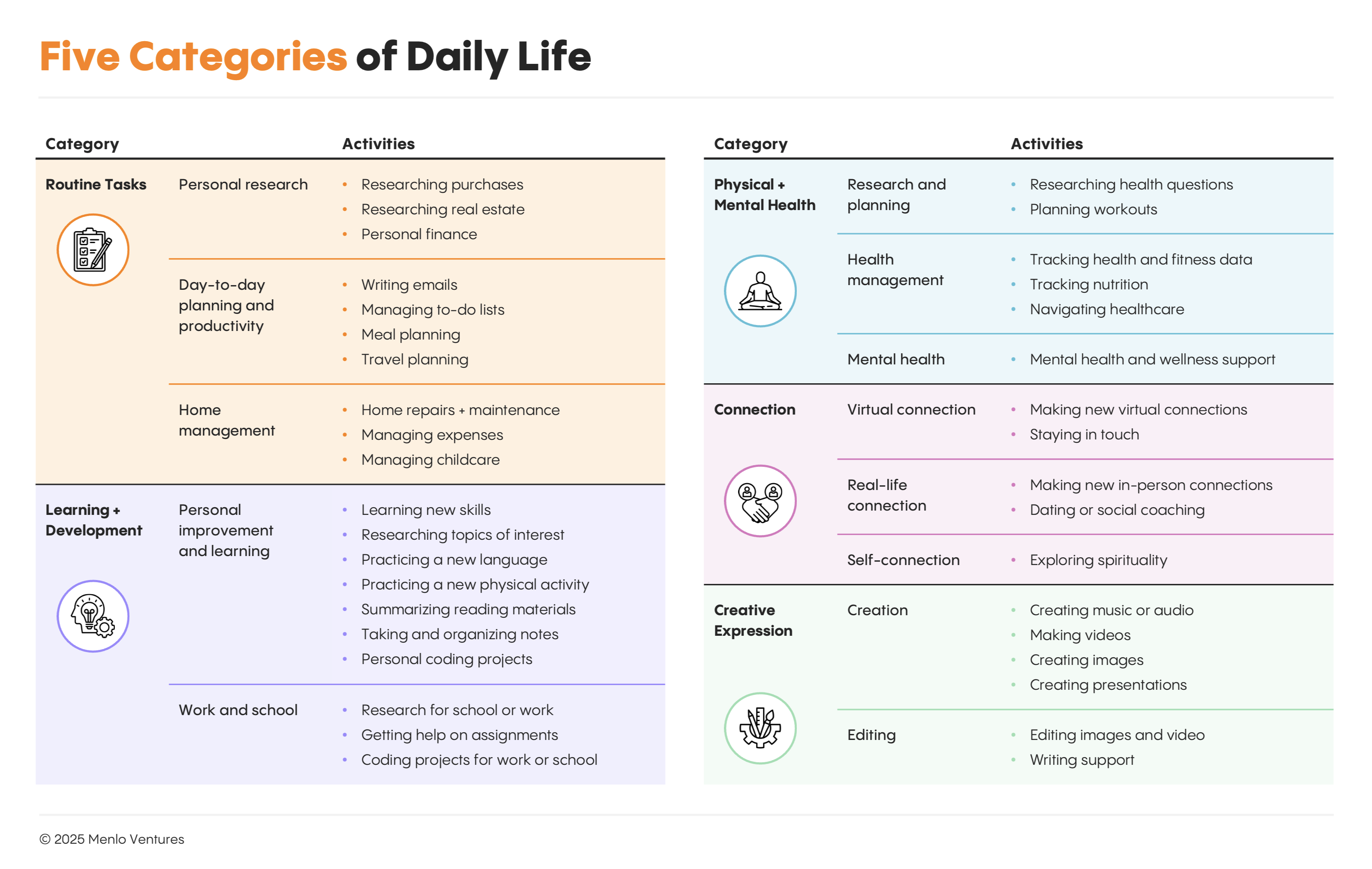
Where AI Delivers the Most Value: The 10 Most Common Ways People Use AI Today
Using our survey data, we define AI usage in two key ways:
- Activities with highest AI usage
These are the tasks for which the largest share of all U.S. adults reports using AI—regardless of whether everyone does the activity or not. This highlights which tasks contribute most to overall AI adoption and shows where AI is becoming part of everyday routines for American adults. - Activities with highest AI penetration
These are the tasks or categories where AI usage is most prevalent among people who regularly do those activities. This shows where AI has real traction and delivers clear value in daily life, highlighting the use cases with the strongest practical adoption.
In terms of the activities with the highest AI usage: Across the country, 19% of U.S. adults use AI to help write emails. Another 18% rely on it to manage to-do lists, research topics of interest, and get writing support. Sixteen percent use it for meal planning, while 15% turn to AI to manage expenses, organize notes, and create images. Finally, 14% use it to research health questions.
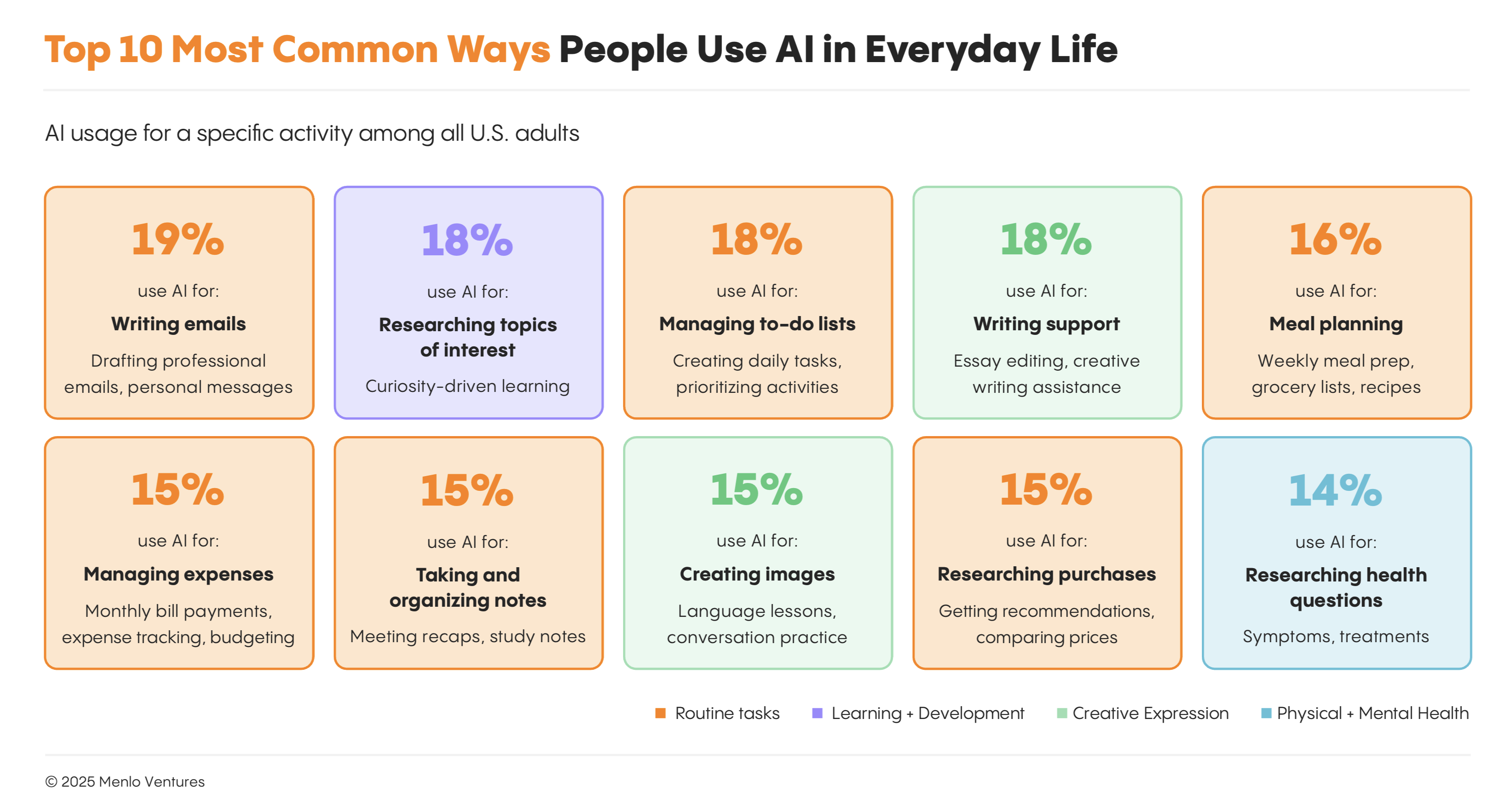
While AI shows broad utility, adoption for any single task remains surprisingly shallow. Although more than half of U.S. adults report using AI, not one activity sees more than one in five relying on it. Even the most common use—writing emails—tops out at just 19%. Rather than one dominant use case, adoption is thinly spread across a wide range of tasks. This underscores both the versatility of today’s general AI tools and the reality that AI must deliver deeper value to drive greater usage and more consistent habits.
Takeaway: AI is useful everywhere, but there’s still a long way to go to everyday adoption, signaling opportunity for new products to convert casual use before daily habit is locked in.
In terms of activities with the highest AI penetration: On this measure, writing leads with 51%, followed by coding (47%), getting help with work or school assignments (43%), designing presentations (38%), and creating music or audio (37%). The pattern is clear: Adoption is strongest where AI naturally fits how people work and delivers obvious, tangible value.
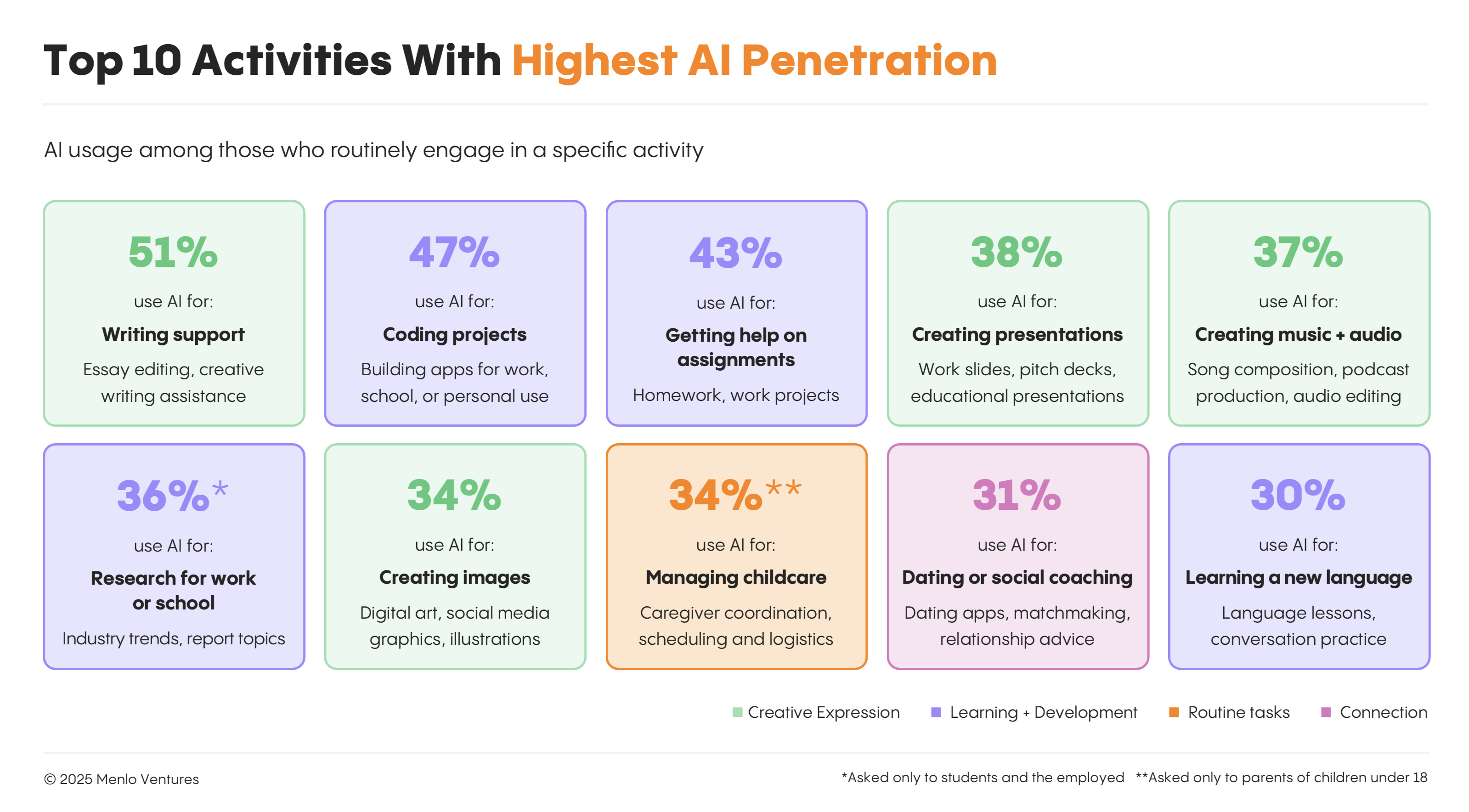
Deep Dive: How Consumers Use AI Across Five Areas of Daily Life
Category: Routine Tasks
From meal planning to managing to-do lists and childcare coordination, these mundane, repetitive tasks keep life on track. AI is ideally suited for these types of low-stakes, high-frequency work, but most people still muscle through manually. While AI usage is highest here, fewer than one in five use AI for common tasks like writing emails, paying bills, or organizing their day, leaving plenty of room for growth. The one clear outlier is parents: More than a third (34%) of people with children under 18 already rely on AI to lighten the load.
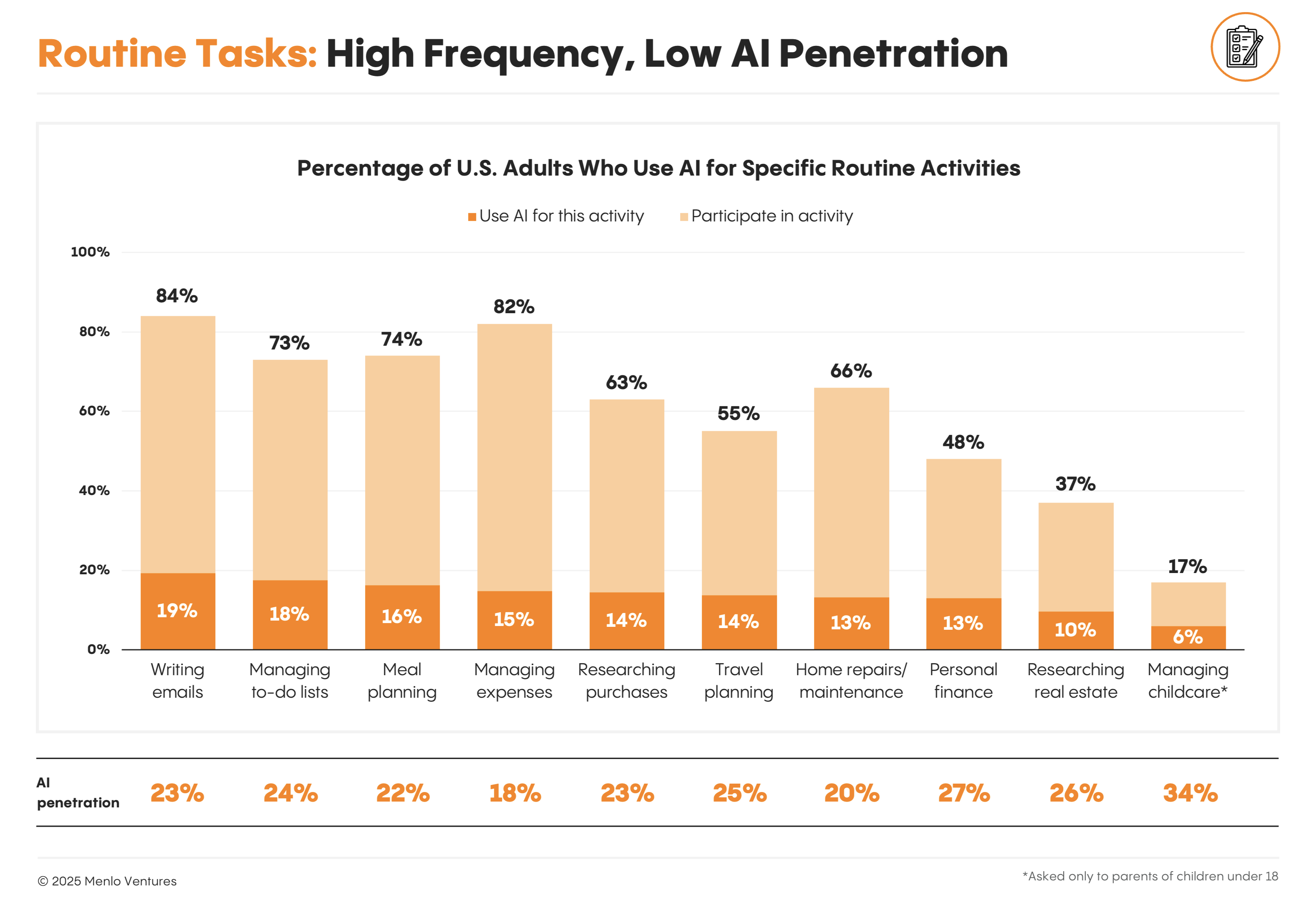
When adopted, AI doesn’t replace skills; it enhances them. It drafts the first version while people stay in control, editing and refining the result. The impact is clear: Creativity flows more easily, code gets written faster, and presentations look more polished. When AI proves valuable for everyday tasks, usage becomes second nature—not just part of the workflow, but central to it.
I’m very busy, and it makes my life easier and clears up needed time to work in other areas in my career.”
—63-year-old female teacher
I was having trouble breaking down numbers and planning out my budget, and AI made it a lot easier and gave me alternate paths to take. It was also less embarrassing than telling someone else about my financial issues.”
—23-year-old male student
Before I buy anything online, I ask AI to look for discount codes.”
—42-year-old female
Takeaway: When it comes to routine tasks, convenience and familiarity beat specialization. General AI assistants are “good enough” for most needs, so people stick with what’s simple and already woven into their daily routines. Specialized tools often add friction—asking users to sign up, learn new interfaces, complete extra setup, or input more data. Every extra tap or step slows people down. If a general AI assistant does the job, that’s reason enough to stick with the default. In consumer AI, convenience usually wins.
Category: Creative Expression
Whether it’s writing, designing, generating images, or making music, AI is becoming an integral part of the creative workflow. Among all the tasks we studied, writing has the highest AI usage, with more than half of respondents (51%) using AI to help them write. Other creative activities with high adoption include building presentations (38%), making music and audio (37%), and image generation (34%). This is more than experimentation; both creatives and non-creatives are increasingly turning to AI to amplify what they can do.
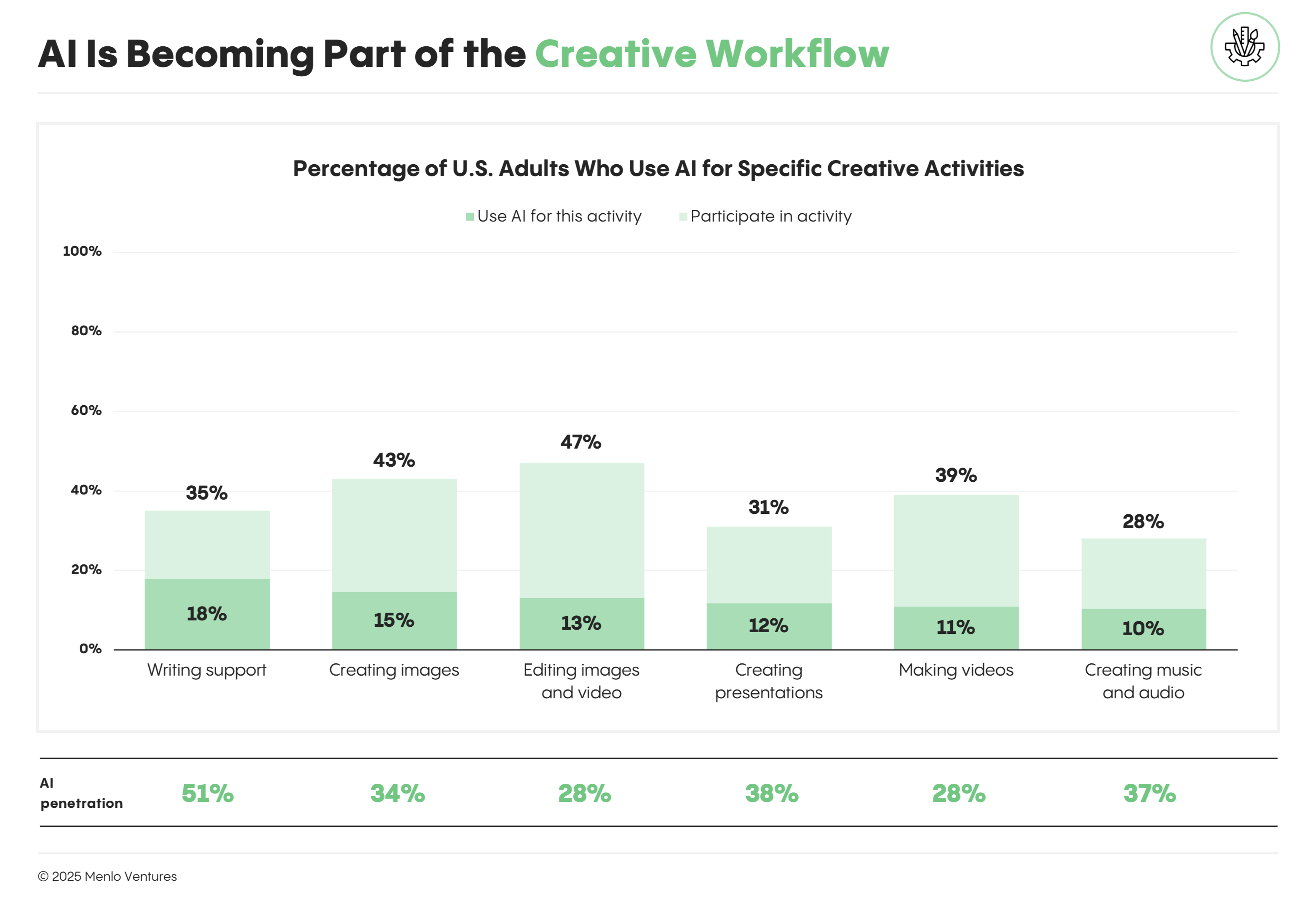
I’m bringing out more creativity because [AI] shows me samples and then it gets my mind going and I come up with good ideas.”
—59-year-old woman working in primary/secondary education
AI acts like a smart assistant, helping me polish content while maintaining my personal style. It’s a great way to enhance productivity without losing originality.”
—45-year-old woman working in tech
I use it to write funny songs for my boys.”
—44-year-old working mom
Expanding TAM: Just as Canva democratized design and Figma redefined UX collaboration, AI lowers the technical barrier to entry, inviting people who never saw themselves as “creators” to produce polished work without formal training. As friction drops, participation rises: AI augments human creativity and becomes central to the process.
Compression in the middle: As AI tools empower non-experts to produce quality creative output, the floor is rising—and the walls are closing in on the middle of the market. Consumers are increasingly creating on their own rather than outsourcing to platforms like Fiverr, Etsy, or template marketplaces. At the same time, the standard for true craft and distinctive taste is rising: Only work that significantly exceeds what AI can produce, in both quality and originality, will stand out and justify a premium.
Tool behavior: General AI assistants are still used by 60–72% of people working on creative tasks, but 25–32% now also use specialized AI creative tools, which is the highest adoption rate of any category, especially for visual and audio work where polish matters most. Canva dominates, accounting for 44% of specialized AI tool use, followed by Gamma AI (20%), Leonardo AI (14%), and Midjourney (13%); Jasper and Runway round out the list at 12% each.
Monetization: Among the specialized AI tools (which represent 18-20% of total consumer AI spend), tools for Creative Expression capture the largest share of spend at 45%, driven by strong demand for media-specific, best-in-class experiences. Creative tools like Higgsfield* and Suno have seen explosive revenue growth as users willingly pay for image generation, audio production, and advanced design where customization and quality output matter most.
Takeaway: The creative category is increasingly AI-native; it’s where consumers most often adopt specialized tools and show a higher willingness to pay. As it becomes easier to produce polished content, taste—the human eye for what is good, fresh, or interesting—becomes the key differentiator. With new image and video models emerging constantly, users care less about which tool they use and focus more on how to control, edit, and refine what AI generates.
Category: Learning and Personal Development
From learning new languages to polishing coding skills, researching topics to summarizing articles, taking notes, and getting help with homework, AI is becoming embedded in how people learn, absorb information, and develop new skills. When Americans engage in learning or personal development activities, nearly half (43%) use AI for academic support, 36% use it to do research for work or school, 30% use it for learning languages, and nearly a third delegate tedious tasks like summarizing articles (28%) and taking notes (26%) to AI.
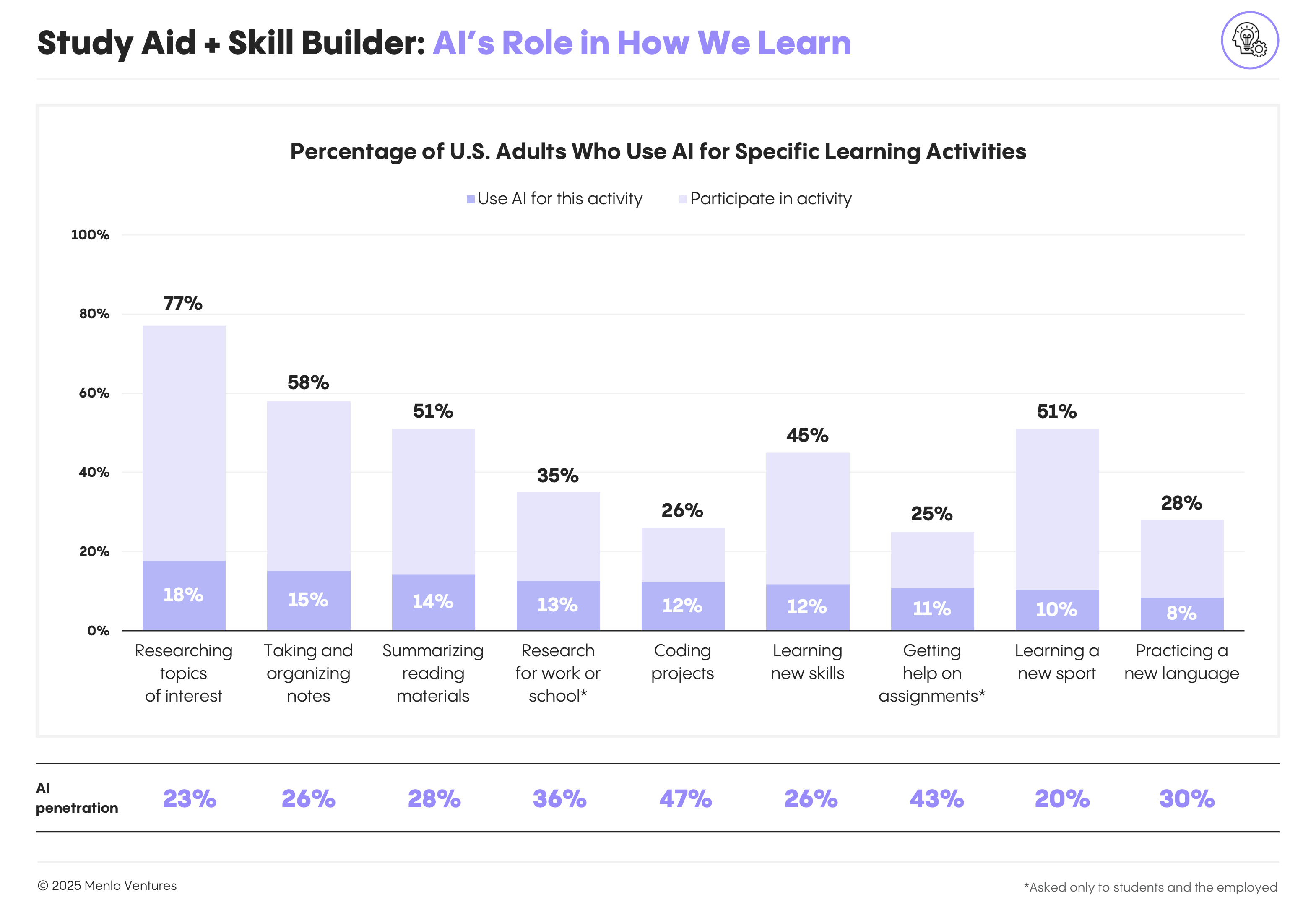
I use AI in my personal research to reduce time and effort in collecting information and reducing wasted effort. I utilize it for research into facts, policies, and positions that are generally in juxtaposition to my own opinions.”
—68-year-old retired man
I needed to learn something quickly for an upcoming presentation. AI was the best resource at the ready.”
—30-year-old self-employed woman
Tools: General AI assistants lead for most activities, but in language learning, consumers prefer specialized tools like Duolingo Max (26%) and Speak (21%) because they offer immersive and progressive experiences that today’s general AI assistants simply can’t deliver.
TAM Expansion in Coding: The rise of vibe coders—non-technical developers building apps with natural-language prompts and AI scaffolding—shows how accessible tools can dramatically expand the market. What was once a specialized skill is now becoming a creative outlet: 47% of users apply AI to coding for work or school, and 41% use it for personal projects. Explosive growth stories like Cursor’s jump to a $500M+ run rate in just two years, demonstrate strong task-technology fit. Website builders like Lovable have reached over $60 million in ARR in under a year. Much like photo editing or slide design before it, AI-assisted coding is becoming foundational digital literacy, and the TAM for creation tools is growing along with it.
I definitely vibe code. It’s sooo much faster than typing especially when trying new libraries, components or designing for best practices.”
—39-year-old male working in tech
I used Claude Sonnet to write a web app where I can batch upload hundreds of files and convert them into one single plain text document that I can then use for AI training. This really makes me want to see what other cool stuff I can play around with, mostly for fun.”
—28-year-old female lawyer
Takeaway: The total addressable market for Learning and Development is expanding as AI helps people build practical skills such as coding, app development, and learning a language into their regular workflows. Learning and development tools succeed when they show measurable progress and a clear return on time invested. Personalization and strong context matter, and the most effective solutions are embedded directly into the apps and devices people already use, from email and calendars to browsers.
Category: Physical and Mental Health
While most Americans regularly engage in health-focused activities, only 14% use AI to help. When they do, it’s mostly for structured, data-driven tasks like tracking nutrition and vitals, not for jobs that require empathy, nuance, or trust. The gap between task frequency and AI adoption reveals a goldmine of untapped demand. People want help with these tasks; they’re just waiting for the right tool to show up.
The Mental Health Perception Gap: Nowhere is the disconnect between hype and behavior more striking than in mental health. Despite claims that AI is replacing therapists, only 21% of the 41% of U.S. adults who sought mental health support in the past six months turned to AI—only 9% of the total population.That mismatch between hype and behavior shows up across wellness. Of the 71% of people who researched health questions, only 20% used AI to help; of the 69% who navigated the healthcare system, only 11% used AI; and although 62% of adults planned workouts, only 18% did so with AI support.
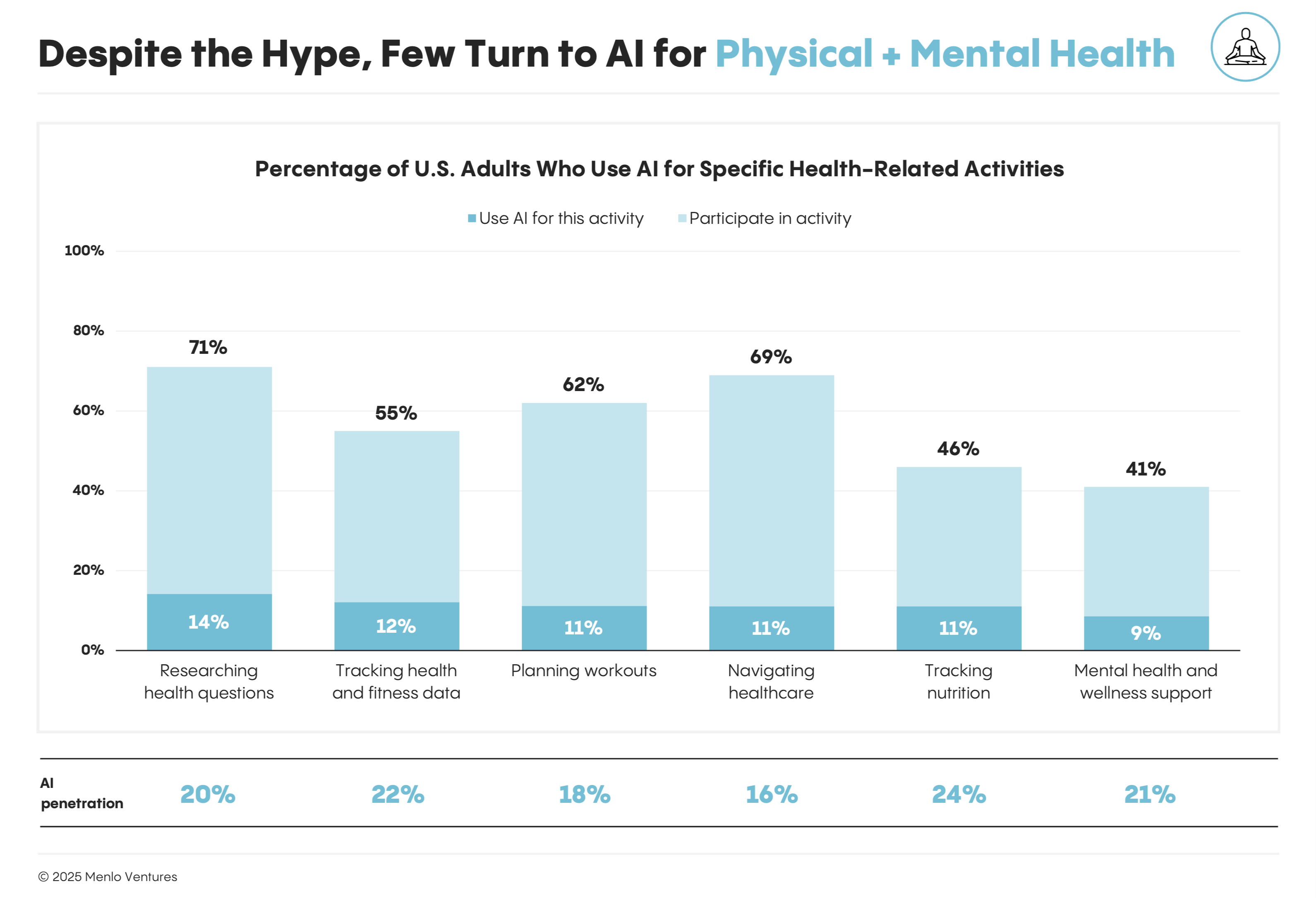
Tools: Among the relatively small group of consumers using AI for healthcare, most default to general AI assistants. Just 14% use specialized AI tools, and, within that group, Character.AI dominates emotional wellness (used by 38% of respondents who report using AI for mental health concerns), despite offering no clinical rigor. Nearly half of Americans have sought mental health support in the past six months, but only a small fraction turned to AI. That gap between widespread need and low AI adoption signals untapped opportunity for companies like Ash* that combine AI accessibility with clinical-grade treatment. If these tools can match the trust and credibility of a human therapist, they can unlock a meaningful share of the $50 billion mental health market.
More access to information related to my unique health. Fast results. No judging. Remember all the symptoms, no need to repeat.”
—37-year-old self-employed mother
It’s easier than walking two miles to see a doctor because I’m disabled.”
—46-year-old single man living in rural West Virginia
I had bad allergies and nothing was working so I used AI to learn about natural remedies and see if changing my diet could help.”
—55-year-old man
Takeaway: Despite low adoption today, AI is uniquely suited to handle healthcare’s complex, fragmented data. It can process unstructured records and deliver personalized insights beyond human capability. However, trust, privacy, and clinical credibility create higher barriers than in other categories. For now, general AI assistants dominate by default, with consumers often pasting lab results into chatbots. Companies that combine AI’s data intelligence with trusted human care teams are best positioned to earn patient trust, fit insurance models, and scale high-quality care.
Category: Connection
From staying in touch to forming new relationships, people are starting to use AI to help them connect. Whether it’s for dating advice, social coaching, virtual friendships, or exploring personal beliefs, AI’s role in social connection is still emerging but gaining momentum. Eighteen percent of people who use technology to stay in touch have used AI for tasks like starting conversations or finding groups. Adoption is even higher for dating (31%) and virtual friendships (26%). Early trends suggest AI adds the most value when helping people build new relationships, where guidance and personalization matter most.
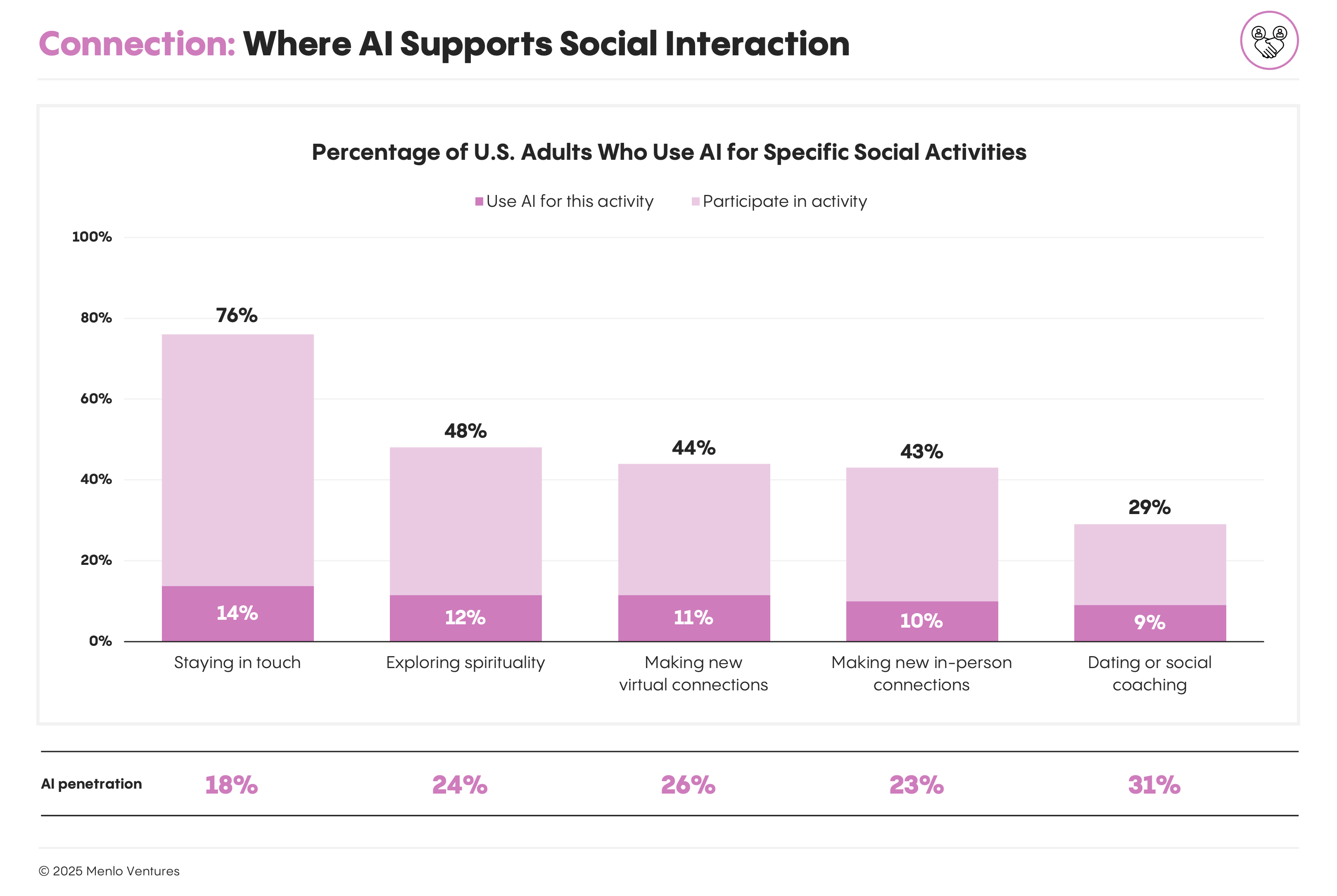
AI can provide great conversation openers and ice breaker questions!”
—23-year-old single man
For a while, I used AI tools to provide companionship since I had just recently gotten out of a relationship and felt lonely. I had no friends to talk to and went to AI for advice.”
—26-year-old single woman
I got in a fight with my father and wanted to explain how he hurt my feelings so he would understand, but I didn’t want to make it worse.. I even prepared for the conversation by describing ways I thought he might push back so I could be ready with responses that would keep us constructive.”
—39-year-old married mother
Tools: General AI assistants remain the default for those using AI to support connection, helping them come up with conversation starters, date ideas, or even roleplay. However, specialized AI tools are quickly gaining traction, especially among users seeking to form new relationships with AI. Character.AI and Replika—both platforms that allow users to chat with AI-generated characters—account for 40% and 18% of specialized AI tool usage, respectively, for social connection. These tools stand out for offering conversational experiences that feel personal, responsive, and aligned with real-world relationship goals.
I needed a friend, but I didn’t want to get too close because I have been hurt in the past. I thought Al could help me find a friend I can trust.”
—78-year-old single retired woman
I’m at a point in my life where sometimes just having somebody unbiased to question and talk to is easier than going out and you know finding a stranger or something. It just makes sense to me.”
—28-year-old unemployed woman
I used AI as a dating coach. I got tips on how to ask someone out, ideas for fun dates, ways to show I was interested, and how to keep the conversation going.”
—31-year-old single man
Takeaway: AI is becoming part of people’s relationships in two ways: it helps connect people to each other, and for some, it becomes a companion itself—a new kind of relationship domain. The biggest opportunities are in “multi-player mode”: personalized matchmaking, proactive connection-building, and social platforms that amplify real interactions, sometimes alongside AI personas.
White Space Opportunities: Where AI Founders Can Break New Ground
Our survey shows a striking gap between how often people tackle personal, essential tasks and how rarely they use AI for help. These aren’t dead zones; they are high-frequency, high-friction, high-trust needs where context, continuity, and accuracy matter most. That’s exactly where general AI assistants fall short today, creating an opening for specialized tools to win.
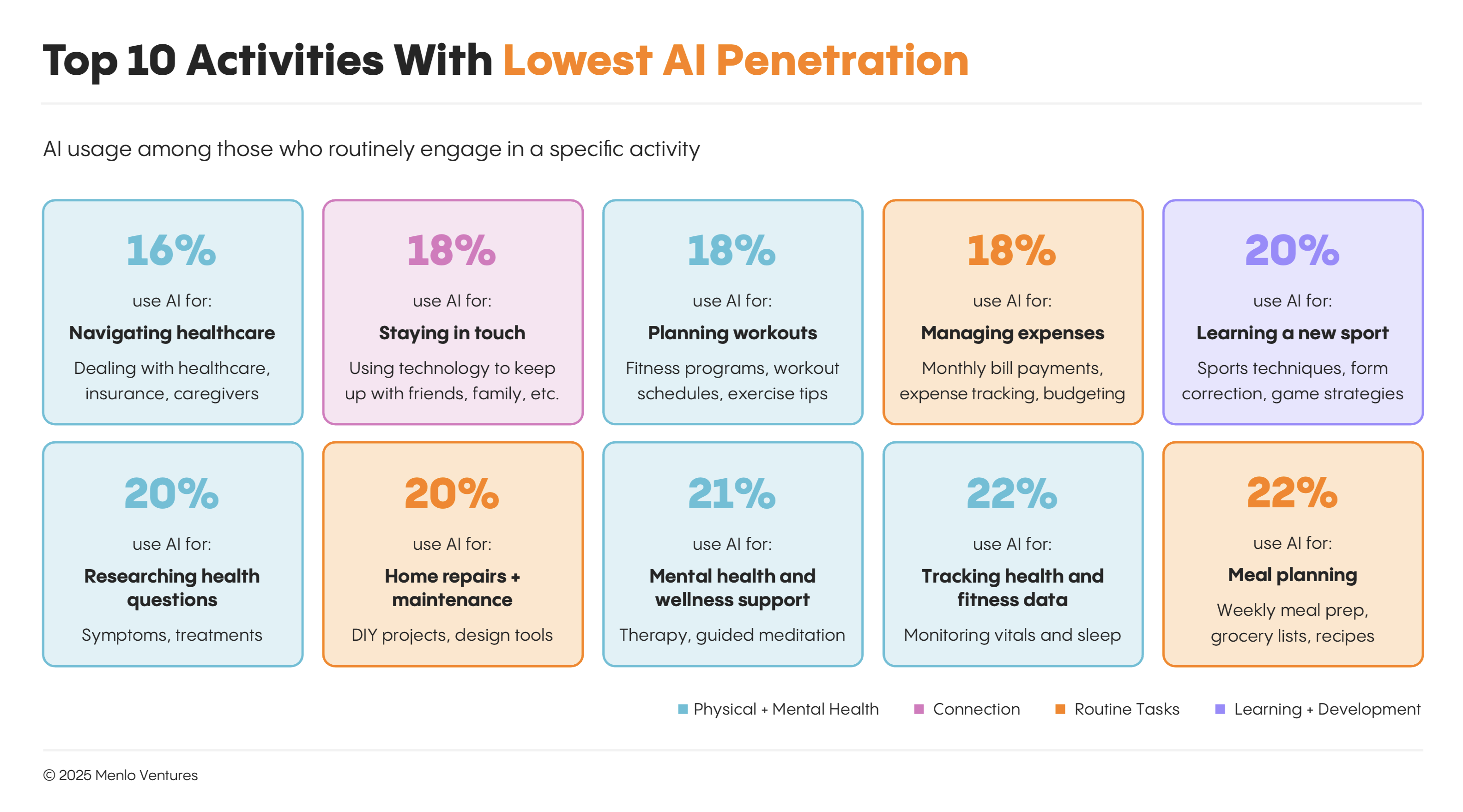
These white space activities share three traits that make them compelling opportunities:
- High frequency: People engage daily or weekly.
- High friction: They’re complex, emotional, and context-dependent.
- High trust: They depend on personal history and nuanced understanding.
Why focus here? While nine out of 10 AI users rely on general AI tools, personal tasks create switching costs once people find a solution that works. Unlike writing, where “good enough” is acceptable, these jobs demand a specialized experience worth paying for. Already, 60% of users combine general and specialized tools, showing that workflows are evolving and these high-trust categories can support premium, defensible products.
Healthcare and wellness: 71% of people research health questions, but only 20% use AI to do it. This gap signals strong demand for trusted, personalized care. In D2C, companies like Ash* combine AI-generated insights with licensed therapists for hybrid care, while Curai Health brings AI to primary care to offer a more personalized experience with 24/7 access to a care team. Also interesting are companies that sit at the nexus of AI and proprietary personal health data, like Function Health*, that are in a strong position to launch valuable features to offer pinpoint-personalized insights. These approaches point the way for new players to blend AI’s accessibility with clinical-grade care and credibility.
Financial management: 82% of people pay bills, but only 16% use AI to help. This mismatch highlights an opportunity to simplify financial chores and deliver clear ROI. Companies like Monarch* are laying the groundwork by aggregating personal transaction data, giving AI a clear opportunity to deliver more powerful insights, visualizations, and optimizations. There’s also room to innovate by making payments faster, easier, cheaper, and more secure.
Connection: 76% of people actively connect with friends, yet only 14% use AI to stay in touch. This points to a wide-open market for “multi-player” social AI that facilitates human connection rather than replacing it—think AI-powered matchmaking, relationship coaching, and playing games or participating in online activities with a combination of human and AI friends.
Personalized learning: 77% of people are actively learning, but only 18% use AI for it. There is huge potential for AI that acts like a personal coach beyond language learning—explaining concepts, closing skill gaps, and adapting to individual learning styles. We’re excited about AI that guarantees measurable progress and fits naturally into people’s hobby and academic routines.
Home-related tasks: 66% of people report managing repairs and maintenance, but only 13% use AI to do it. Home-related expenses are one of the largest categories of consumer spend today, and the gap between task frequency and AI adoption signals untapped demand for AI that helps with everything from contractor vetting and matching to DIY guidance.
Family logistics: Only 34% of parents use AI despite childcare and coordination being among the highest-friction tasks. This complexity creates clear room for specialized, family-friendly AI that simplifies scheduling, homework, and household organization while offering access and accessibility to multiple family members and caregivers.
Consumer AI Market Map
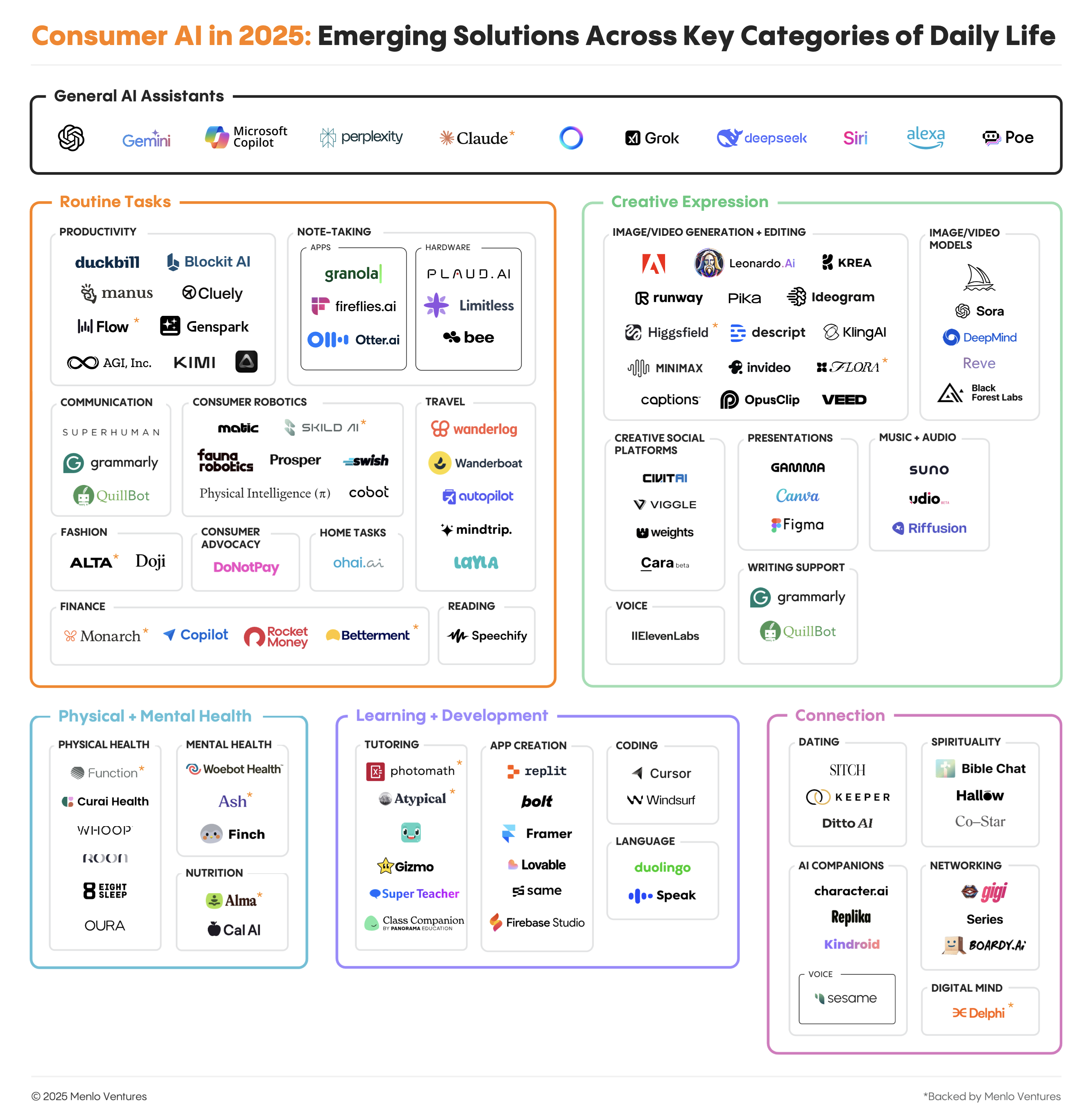
Takeaway: Competing where general AI assistants do “just fine” is an uphill battle. Founders can create real value by tackling personal, high-trust tasks where generic tools fall short—and where people will pay for solutions that truly work. As investors, we’re excited to back the builders who focus here, creating products sticky enough to earn trust and strong enough to command premium pricing.
While these white space opportunities represent massive potential for AI founders, there’s another critical piece of the puzzle: understanding why some Americans haven’t embraced AI at all. Their hesitation points directly to what AI products must solve to earn trust and become truly indispensable.
The Holdouts: What Drives AI Resistors and Rejectors?
While 61% of Americans have embraced AI, a substantial 39% remain unmoved. These resistors and rejectors aren’t simply Luddites or technophobes; they’re thoughtful consumers who haven’t yet found a compelling reason to weave AI into their daily lives. Understanding what holds them back reveals both the challenges and the opportunities for the next wave of consumer AI adoption.
A Spectrum of Resistance
Our survey revealed many overlapping concerns among non-adopters, but one barrier stands out above the rest: human connection. A striking 80% say they prefer interacting with people over machines, a belief that goes beyond convenience and speaks to how they think important tasks should be done. Related to this, 53% say they need to feel accountable to another human; they want oversight, responsibility, and real connection in how decisions get made.
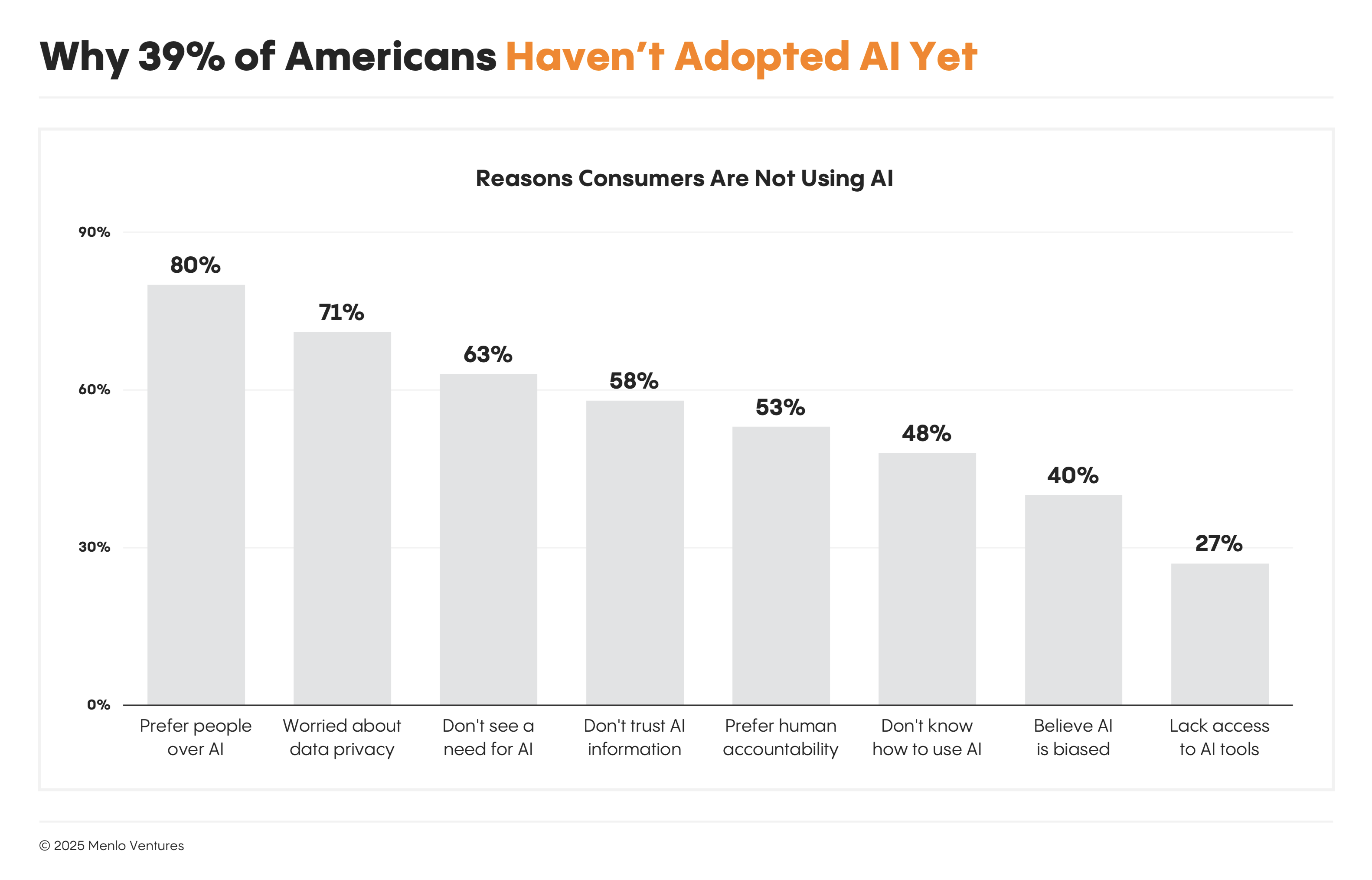
I feel like people have stopped using their own brains these days. By using AI, it takes human creativity out of it and human independent thinking out of it.”
—47-year-old woman
Replacing human interaction, creativity, thinking, and problem-solving skills sets a dangerous precedent for how we use our brains – which will wither without practice.”
—27-year-old self-employed man in media industry
I don’t believe AI tools are sophisticated enough yet to perform well in many applications.”
—50-year-old woman
Trust is the second major hurdle. Nearly three-quarters (71%) worry about data privacy and security, 58% don’t trust the information AI provides, and 40% believe AI tools are biased. Far from abstract, these are practical deal-breakers that keep people from trying AI in the first place.
A relevance gap slows adoption further: 63% say they simply don’t see a need for AI in their daily lives. This suggests many current applications haven’t demonstrated enough tangible value to feel essential—or that some people aren’t willing to give AI tools a try.
Finally, many holdouts face a knowledge and access barrier: Nearly half (48%) say they don’t know how to use AI tools effectively, pointing to an onboarding challenge that better design and clearer guidance could help solve. Another 27% say they lack access altogether, showing that availability and distribution still matter.
Takeaway: AI holdouts aren’t anti-technology; they just haven’t had their “aha moment” yet. Some haven’t tried. As behaviors shift over time and the technology continues to improve, we expect many of these barriers to adoption to decline.
Six Predictions for Consumer AI
Based on what we’re seeing in the market and hearing from founders, in combination with our survey data and analysis of current adoption patterns, we see six major shifts reshaping consumer AI over the next 18 to 24 months.
- The Second Wave: Specialized Tools Go Mainstream
Nearly two-thirds of Americans now use AI, and the first wave dominated by general AI assistants is well underway. Starting this year, expect specialized tools to gain traction and move into the mainstream. The challenge will be defensibility. We’re looking for products that replace complexity with simplicity, embed persistent memory, have strong integrations, and unlock and train with proprietary user data. - From Assistant to Automation: AI Takes Over Entire Workflows
Today’s AI handles discrete tasks like drafting text or generating images. The next generation will run complex workflows from end to end. Think travel planning: researching options, booking tickets, arranging transport, checking in, and booking activities and restaurants automatically. In healthcare, AI will find top in-network providers, book appointments, manage forms and insurance, schedule follow-ups, and send aftercare reminders. Every step is handled by AI; the consumer is the ”human-in-the-loop,” with oversight and final approval rights. Simply “click to confirm” at the end. - From Single to Multi-Player
Most AI models and general AI platforms aren’t inherently social today. Products that build “multi-player” experiences—ideally with built-in network effects—not only stand out but also gain more defensible distribution and engagement. - Voice AI Takes Off
Voice AI is set for growth as speech recognition reaches near-perfect accuracy and major players upgrade their engines. Of those using AI for routine tasks, 32% use Alexa and 25% use Siri despite current limitations. With LLM-powered intelligence, voice interfaces like Wispr Flow* and Superwhisper, and future integrated hardware devices, voice can become a more natural interface for ambient, proactive AI. - Physical AI Will Enter the Home
Beyond the ongoing revolution in self-driving cars led by Tesla, Waymo, and NVIDIA, we predict that the next wave will bring consumer robotics into our homes. Early-stage companies like Matic, Fauna, Prosper, and Swish—built on foundational models such as Skild* and Physical Intelligence—will help people tackle physical tasks in and around the house. This marks the shift from digital assistance to real-world action, a frontier that is still in its early days but poised to grow rapidly. - Revenue Models Diversify Beyond Subscriptions
The biggest long-term monetization opportunities won’t be subscriptions. We expect rapid adoption of advertising models, transaction fees, affiliate revenue, and marketplace models. Creative AI tools are already pioneering this shift.
Closing Thoughts and One Last Takeaway
At Menlo Ventures, we believe generational companies are born when real consumer needs are met by major technology shifts. Today, that shift is AI—evolving from early experimentation to everyday utility at an unprecedented pace.
The takeaway from this report is clear: People embrace tools that solve real problems better, faster, and cheaper than traditional approaches. That simple truth is the cornerstone of our investment thesis and echoes throughout this report. At Menlo, we back founders who understand this dynamic and build solutions people depend on to tackle the persistent problems of everyday life.
If that sounds like you, we’d love to connect.
- Based on our survey’s adoption rates, we estimate there are approximately 1.7–1.8 billion global AI users today. While 61% of U.S. adults report using AI in the past six months, the global estimate adjusts downward to account for differences in internet access, age distribution, and regional adoption rates—recognizing that the U.S. currently leads much of the world in AI engagement relative to population size. ↩︎
- In April 2025, Menlo Ventures partnered with Morning Consult to conduct a survey of 5,031 U.S. adults. The sample is nationally representative, with weights applied for education, gender, age, race/ethnicity, and region. The survey explores how consumers have used AI and other tools to complete specific activities in the past six months, along with their attitudes toward the technology. ↩︎
- For comparison: Facebook took roughly five years post-launch to reach significant ad revenue ($777M in 2009 with ~360M users), translating to ~$2/user annually. Twitter had over 200 million users before it reached $1 billion in annual revenue in 2014 (eight years in). Google AdWords took four years to reach $1 billion in revenue. Mobile app stores (Apple App Store, Google Play) took three to four years to drive meaningful consumer spend. Consumer AI, by contrast, reached 1.7–1.8B users in just 2.5 years—with only ~3% paying—highlighting both the scale and velocity of the current monetization gap. ↩︎
- Estimate based on OpenAI’s reported $10 billion annual revenue run rate and approximately 800 million monthly active users. Assumes a ChatGPT Plus subscription price of $20/month ($240/year), implying roughly 5% of users pay for premium access. ↩︎
- Gemini is embedded into the Google Chrome browser and Gmail. ↩︎
Banner video created using FLORA*
* Backed by Menlo Ventures
As an early-stage investor, Shawn focuses on companies that serve the “utilitarian consumer”—the individual seeking better, faster, and cheaper ways to move through life. Because basic human needs are persistent, he looks at how people are spending their money and time to assess the value and utility of a product…
Amy came to Menlo Ventures to grow the firm’s consumer technology and gaming practice and back founders building new products at the forefront of emerging platform shifts. As an investor, Amy seeks founders who share her obsession with products that define how people work, live, and play. She believes that emerging…
C.C. is a principal at Menlo Ventures focused on early-stage consumer tech and SaaS investments. Drawing on her extensive experience as a product leader and team builder, C.C. goes all in on supporting founders who optimize for impact. She believes that personalized AI will revolutionize the next generation of human-computer…
As an investor at Menlo Ventures, Sam focuses on SaaS, AI/ML, and cloud infrastructure opportunities. She is passionate about supporting strong founders with a vision to transform an industry. Sam joined Menlo from the Boston Consulting Group, where she was a core member of the firm’s Principal Investors and Private…





